Medication delivery service comes to campus
■ The Student Union partnered with e-pharmacy Capsule to deliver over-the-counter and prescription medications to University students.
By ISABEL ROSETH JUSTICE EDITOR
With the numerous hills, stairs, and limited number of elevators, accessibility — or rather inacces sibility — has long been a point of contention on campus. This rang true for Hana Klempnauer Miller ’25 as she managed the Student Union presidential campaign of Peyton Gillespie ’25 and Lia Ber gen ’25. Through personal experi ence and testimonies from other students, Miller became increas ingly aware of the lack of acces sibility at the University. This ap plied to many areas of campus, but one relatively unexplored need was that of access to medications.
After meeting with the Disabled Students Network, it was clear to Miller that there were simply more accessibility issues to ad dress than the director of health and wellness position in the Stu dent Union could oversee. The Stu dent Union needed a new position to focus specifically on Brandeis’ pressing need for increased acces sibility.
Now the Director of Accessibil ity for the Student Union, Miller set her sights on promoting access to prescription medications for University students. While it is true that there are pharmacies in the surrounding area, their loca tions pose challenges to students, whether it is mobility issues or simply a lack of time to go to a pharmacy amid workloads and extracurriculars. The issue ap peared to be a pretty easy fix, as opposed to some more systemic is sues plaguing the University. This semester, through a partnership with the relatively new e-pharma cy Capsule, Miller and the Student Union are aiming to solve this problem, and the initiative will kick off on Oct. 13.
The decision to do so was com pounded by what Miller described as the University’s “hands-off” approach when it comes to acces sibility. To her knowledge, the administration often defers issues of accessibility to Student Acces sibility Services — issues which Miller believes require interde partmental collaboration. Miller and the Student Union hope that partnering with Capsule will tack le problems regarding access to prescription medications, which Miller believes is one of the issues that was deferred to SAS. In her
view, “This is an opportunity for the University to see how easy it is to make accessibility improve ments, and how they can better support those kinds of initia tives.”
Miller first heard about Capsule from Dr. Colleen Collins, the med ical director of the Health Center at Brandeis. Capsule, she learned, had reached out to campus health centers in the past, and because of that, a lot of campus practitioners are aware of their existence. “It kind of just stuck in the back of my mind,” Miller said in an Oct. 2 Zoom interview with the Justice, “and [when] I was looking at these issues … I came back to Capsule.” She wrote an email to the start up explaining the University’s prob lem with access to prescription medications and proposed a part nership. Within two hours, they responded, willing and enthusias tic to partner with the University.
This new initiative will allow students to order prescription medications directly to campus; students can sign up through Cap sule’s website or download their app. Doctors have the ability to prescribe medications through Capsule like any other pharmacy, and once processed, Capsule of fers same-day deliveries as well as scheduled deliveries to those or dering the medication. Participat ing students will be able to pick a (preferably) easy-to-find loca tion for delivery drivers on cam pus, such as the Admissions Lot. “It’s essentially the same as Uber Eats,” Miller said, “but just with medication.”
The “Uber Eats model” that Cap sule follows brought up a few con cerns, namely about privacy. This, however, will not be an issue, ac cording to Miller. The delivery couriers will not know what medi cation it is that they are delivering to students. That information is kept private between the student and their prescriber. Anonymity is a top priority for both the Stu dent Union and Capsule alike, and Miller said that Capsule has lately taken “incredible steps” to ensure security for their clients. Privacy is of the utmost importance given the medications Capsule provides, which includes prescription medi cation, birth control, and even medications required for a medi cal abortion. Miller also believes it unlikely that prescriptions or orders will get mixed up. “Every package is individually packaged.

It is marked with your name so you know that you are receiving your package,” she explained.
“There are an incredibly compre hensive set of checks and balances
Views from the Crowd
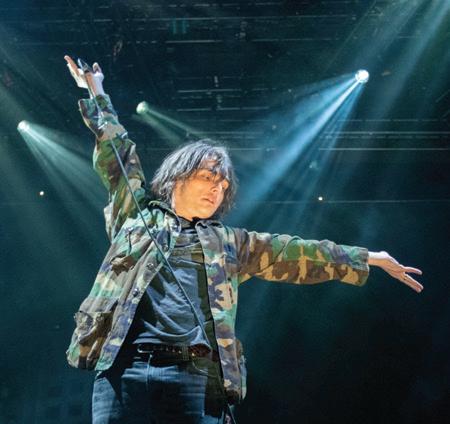 By NATALIE KAHN
By NATALIE KAHN
DINING HALL PROTEST
Harvest Table calls police on student-worker delegation
■ The police were called on Brandeis Leftist Union members who were protesting, alongside a dozen dining workers, the abrupt firing of Kevintz Merisier.

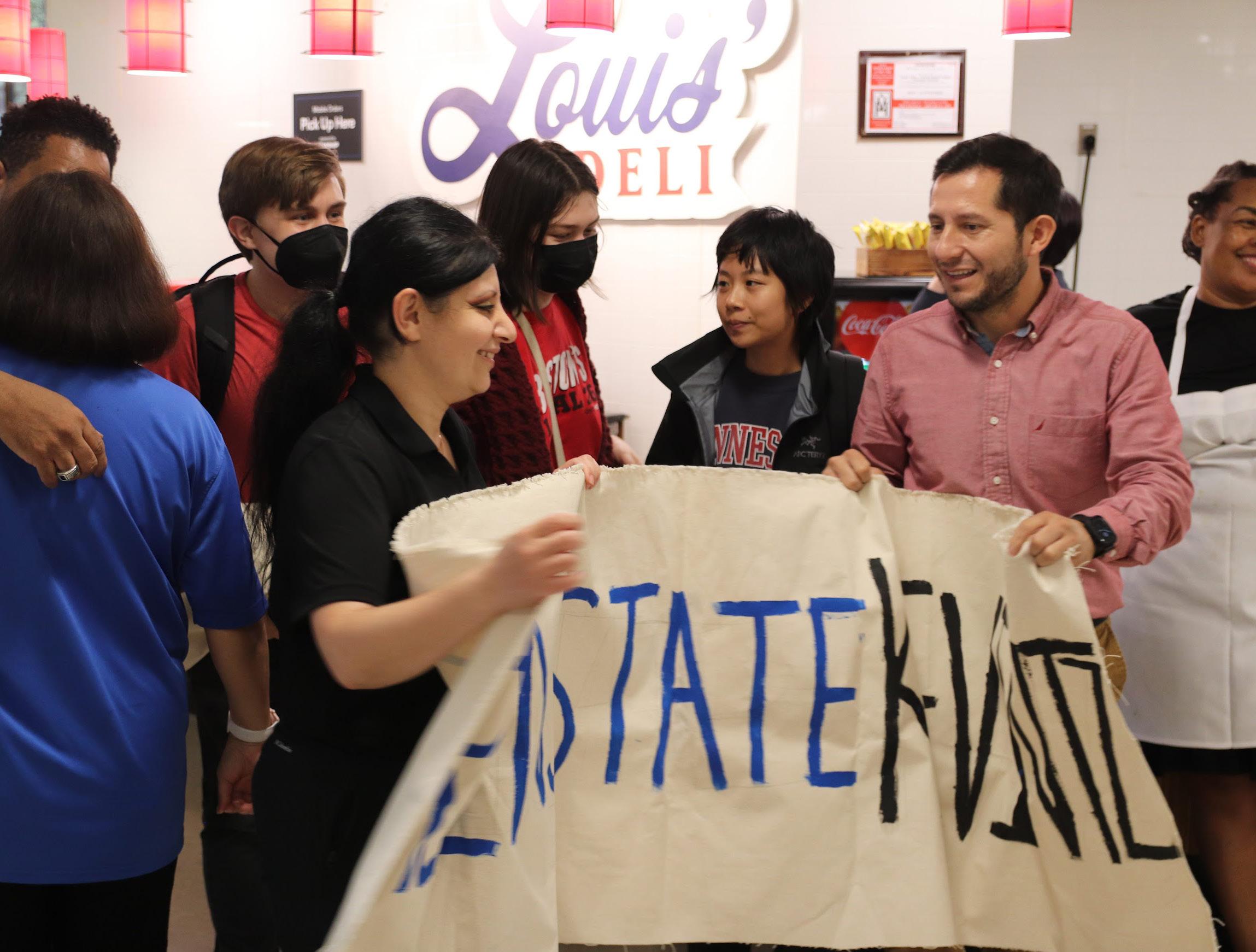 By ARIELLA WEISS, ELLIOT BACHRACH, AND NATALIE SALTZMAN JUSTICE EDITOR AND CONTRIBUTING WRITERS
By ARIELLA WEISS, ELLIOT BACHRACH, AND NATALIE SALTZMAN JUSTICE EDITOR AND CONTRIBUTING WRITERS
At Sherman Dining Hall, there is a black bulletin board adjacent to the entrance. Students can voice their
opinions on brown paper napkins and attach them to the board. One comment read, “Please bring back skim and 2% milk” with a smiley face. A small yellow sticky note at tached on top of the napkin, presum ably from a dining worker or Harvest Table employee, read “on the way!” in response. Sure enough, skim and two percent milk were back in the dairy section. A fair amount of the napkins, however, read statements such as “Reinstate Kevintz.” There were no yellow sticky notes attached to these suggestions. Veteran Catering Lead
Kevintz Merisier was not back on the job. According to dining worker Lucia Hsiung — who also serves as a Union Steward for Boston Lo cal 26, the union that represents the Brandeis dining and catering team — Director of Hospitality Clayton Har grove declined to rehire Merisier on Tuesday, Sept. 27.
Since the dismissal of Merisier on Sept. 7, neither Harvest Table nor the University has released an offi cial statement on his job status. Two weeks later, on Sept. 22, over a dozen
Brandeis Professor unearths Mayan civilizations
and culture to move forward. The article recounts how Golden and his colleague Dr. Andrew Scherer, a bioar chaeologist at Brown University, had been awaiting an opportunity to excavate Mayan ruins — those discov ered just before the pandemic.
By LOLA HAMILTON JUSTICE CONTRIBUTING WRITER
Prof. Charles Golden (ANTH) can be found around campus teaching introductory anthropology courses and attending meetings with students and colleagues. Golden’s responsibilities also include searching to fill in the gaps of human history and uncovering missing pieces to a historical puzzle.
A recent New York Times article documents how Golden uncovered a monumental discovery that con firms the location of the Mayan city Sak Tz’i’. Although there had been guesswork in the anthropological field before, it was the work of Dr. Golden’s team that pre vailed and allowed the understanding of Mayan society
‘Ramy’
By MEGAN LIAO
ARTS AND CULTURE
On Sept. 28, the Justice corresponded with Golden via email about the excavation and what it means for Brandeis students. He acknowledged that the excava tions “are destructive,” but also how he “balance[s] that with efforts to conserve the architecture and other cul tural patrimony.” The New York Times finds the most notable discovery to be a two-by-four wall panel with Mayan glyph inscriptions detailing battles, rituals, nat ural disasters, and descriptions of fantastical creatures in “poetic couplets.” Artifacts with such great detail create “a major advance in our understanding of Clas sic period Maya politics and culture.”
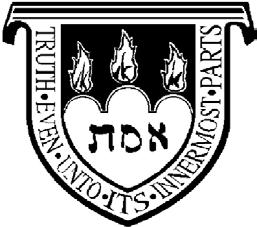
Jancinto Gomez Sanchez, a cattle farmer and resident of the excavation site, took much consideration before
Boston Poet Laureate Porsha Olayiwola visits campus
By AMANDA CHEN
The Board addresses lack of support for student employment
By THE EDITORIAL BOARD
Men’s, women’s soccer teams fall short in UAA Weekend Opener
By AKI YAMAGUCHI
Tuesday, October 4, 2022
recap and some reflections on the previous seasons of the Hulu series ‘Ramy.’
music is back in the Boston area, and the Justice has the photos to prove it.
ELLIOT BACHRACH/the Justice
Waltham, Mass.
WORKER VOICES : The Brandeis Leftist Union gathered students and workers to protest for Merisier's reinstatement.
Photo courtesy
■ Brandeis Prof. Charles Golden (ANTH) has been part of a team working to excavate an ancient Mayan ruin.
Justicethe www.thejustice.org Volume LXXV, Number 4 Waltham, Mass. For tips or info email editor@thejustice.org Make your voice heard! Submit letters to the editor to forum@thejustice.org COPYRIGHT 2022 FREE AT BRANDEIS.
A
T he I ndependen T S T uden T n ew S paper of B rande IS u n I ver SIT y S I nce 1949
Live
FEATURES 7 Photo courtesy of CREATIVE COMMONS
14 FORUM 8 SPORTS 11 NEWS 3
See DINING, 5 ☛
of ZOE POPOVIC
See ANTHROPOLOGY, 5 ☛
See CAPSULE, 5 ☛
Student Union Senate confirms executive board officers, votes on Senate Money Resolution
The Student Union Senate finished its confirmation of executive board officers at the Oct. 2 meeting. Sena tors also voted on a Senate Money Resolution related to a voting drive this week.
The process for e-board confir mations was the same as in the last Senate meeting. Each candidate had two minutes to make their case to the Senate, followed by brief question ing from the senators. The candidate then left the room so that the Senate could discuss and vote.
Emma Fiesinger ’23, the acting Di rector of Community Engagement, was first to speak before the Senate for confirmation in said position.
Fiesinger said that as a Community Advisor and Orientation Leader, she has extensive experience helping to plan events such as New Student Orientation, Homecoming, VoteDeis, and Pumpkin Fest.
“Emma really did play a huge part [in orientation],” said Sen. Tyler Hu part ’26, who attended orientation
POLICE LOG
MEDICAL EMERGENCY
this semester. “I can’t imagine any one else in this role.”
Chief of Staff Tyler Carruth ’23 pre sented on behalf of acting Director of Sustainability and Climate Justice Ana Mejia Cerdas ’25, who could not attend.
Carruth said that Cerdas worked with the building manager of an apartment she used to live in to place a recycling bin on every floor of the building. Carruth also said that Cer das wants to transition the Universi ty to using renewable energy, specifi cally with renewable energy projects on campus. Cerdas also hopes to implement a gazebo on campus with solar-powered charging stations.
“She has the [union] administra tion’s full endorsement,” Carruth said. “She’s done an amazing job.”
Carruth also spoke on behalf of Monica Aponte ’24, the acting Direc tor of Sexual Assault Awareness, which is a new e-board position.
Carruth said that Aponte is work ing with the Student Sexuality In
formation Service to hold an event about sexual safety, and that she also is working with SSIS and the Health Center to provide Plan B to students.
Rani Balakrishna ’25, acting Di versity and Inclusion Officer, asked that the Senate confirm her in that role. Balakrishna, who was one of the Racial Minority Senators last year, said that she has been involved with diversity work since high school, where she started a South Asian stu dents association.
Balakrishna also said that she has been working since last year on compiling mental health resources in multiple languages for international students.
Lotem Sagi ’24 was seeking to be confirmed as Director of Residential Life. Sagi said that she believes that the accessibility of information on campus is lacking, and that the Stu dent Union is a way for her to address that issue.
The Senate confirmed all of these officers by unanimous consent.
Jakey Zackai ’24, the acting cohead treasurer, asked the Senate to confirm him in that position. Zackai said that treasury is a “hard and thankless job,” and that he had done over 1000 hours of office hours as a first-year in treasury.
Zackai also said he is working on rewriting policies to make funding easier.
“I want every club to be able to spend all the money they are allocat ed by A-Board,” Zackai said.
After Zackai left the room, Execu tive Sen. Nicholas Kanan ’23 called the Senate into an executive session, meaning that all members of the public, press, and non-senator union members had to leave the room. After 30 minutes of secret deliberation, the executive session ended, and the sen ators voted 13 to 4 against confirming Zackai.
Noah Risley ’24 spoke before the senate, seeking confirmation as Chief Justice of the judiciary. Risley said that they’ve been in the Student
Union since their first year on cam pus and that they plan on advising students on how the Student Union functions.
The Senate voted unanimously by roll call to confirm Risley.
President Peyton Gillespie ’25 presented a Senate Money Resolu tion to request funding for stickers and cookies to distribute during the Union’s voter drive on Oct. 7.
Gillespie requested $115 for cook ies and $24.49 for two thousand “I registered to vote” stickers. The Sen ate first voted to expedite their vote on the SMR, meaning that they voted on it at the same meeting it was pro posed rather than waiting a week. The Senate then voted unanimously to approve the SMR.
 Max Feigelson
Max Feigelson
Sept. 20—There was a medical emergen cy in East Quad. The party was treated by BEMCo staff and transported to a local hos pital via ambulance.
Sept. 20—There was a medical emergen cy in the Stoneman Building. The party was treated by BEMCo staff and refused further care.

Sept. 20—There was a medical emergen cy in Farber Library. The party was treat ed by BEMCo staff and transported to a lo cal hospital via ambulance.
Sept. 21—There was a medical emergen cy in the Village. The party was treated by BEMCo staff and transported to a local hos pital via ambulance.
Sept. 21—There was a medical emergen cy on the athletic fields. The party was treated by BEMCo staff and refused further care.
Sept. 22—There was a medical emergen cy in the Charles River Apartments. The party was treated by BEMCo staff and tran sported to a local hospital via ambulance.
Sept. 22—There was a medical emergen cy in the Rabb Graduate Center. The party was treated by BEMCo staff and refused further care.
Sept. 22—There was a medical emergen cy in the Golding Health Center. The party was treated by BEMCo staff and transport ed to a local hospital via ambulance.
Sept. 22—There was a medical emergen cy in the Mailman House. The party was treated by BEMCo staff and transported to a local hospital via ambulance.
Sept. 22—There was a medical emergen cy in the Berlin Chapel. The party was treated by BEMCo staff and transported to a local hospital via ambulance.
Sept. 24—There was a medical emergen
CORRECTIONS AND CLARIFICATIONS
The Justice welcomes submissions for errors that warrant correction or clarification. Send an email to editor@ thejustice.org.
cy in Massell Quad. The party was treated by BEMCo staff and transported to a local hospital via ambulance.
Sept. 25—There was a medical emergen cy in North Quad. The party was treated by BEMCo staff and transported to a local hos pital via ambulance.
DISTURBANCE
Sept. 22—A Dining Services staff mem ber reported a group of protestors in the kitchen in Sherman Dining Hall and re quested police assistance. The protestors were gone upon police arrival. Sept. 24—A community member report ed a noise complaint in Foster Mods. Com munity Living was enlisted to handle the situation.
MISCELLANEOUS
Sept. 18—There were bees in a bedroom
in Foster Mods. DFM was notified to hand le the situation.
Sept. 21—A community member report ed harassment via telephone in the Heller School of Social Policy and Management. A report was composed.
Sept. 21—A community member report ed theft of food from the common kitchen in Skyline Residence Hall. A report was composed.
Sept. 22—A community member report ed a harassment incident. A report was composed.
Compiled by Leah Breakstone
Univ. receives grant from the Mellon Foundation for humanities centers
The University has received a 15-month $150,000 grant from the Andrew W. Mellon Foundation, an organization that is committed to supporting the arts and humanities and giving all students and communities the opportunity to study and interact with the field. The grant is intended to aid in “re-en visioning the role of the humanities center in the 21st-century university,” as a part of the Mellon Foundation’s efforts to improve upon humanities centers at higher learning institu tions.
The Mellon Foundation dedicates an entire program to awarding grants to colleges and universities committed to so cial justice and the humanities. According to the Foundation’s website, these grants are meant to help “broaden our under standing of American history and culture; develop the inter pretive tools and methods researchers use to create meaning; support faculty and students whose work exemplifies a drive toward greater equity in their fields and institutions; and pro mote pathways for those seeking to exercise transformative academic leadership.”
At Brandeis, the procurment and implementation of this grant money has largely been driven by Prof. Ulka Anjaria (ENG), the director of the Jack, Joseph and Morton Mandel Center for the Humanities. Anjaria will lead the University in building a group that will work to provide the institution with the resources needed to address the issues at the forefront of the humanities today. These issues include ensuring more equitable access to a comprehensive humanities education among college-age students, mending the University’s relation
ship with nearby communities, building a more engaging liber al arts curriculum by highlighting practical skills, and improv ing the role of the humanities and liberal arts in post-graduate doctoral programs.
This group, led by Anjaria, will include humanities depart ment faculty, directors, and leaders from several institutions of higher learning who consider the aforementioned issues to be a priority. These leaders will meet twice throughout the current academic year. At the meetings, they will share their insights on the humanities-related issues that they have ob served at their specific institutions. By summer 2023, they will draft and publish a detailed report describing these insights with the hope that the information they share will help insti tutions across the country create a more equitable, accessible, and humanities-centered future.
The Foundation’s grant utilizes three core strategies in or der to best accomplish its mission. As the website describes, it focuses on perpetuating a more holistic portrayal of the hu man experience, creating more diversity in leadership among humanities faculty at higher learning institutions, and in creasing equitable access to humanities resources and learn ing opportunities.
— Sydney Duncan
NEWS 2 TUESDAY, OCTOBER 4, 2022 ● NEWS ● THE JUSTICE
SENATE LOG
Follow theJustice! @theJusticeNewspaper Image courtesy of CREATIVE COMMONS Do you have a nose for news? Contact Leah Breakstone and Dalya Koller at news@thejustice.org Want the scoop? Image courtesy of CREATIVE COMMONS
BRIEF The Justice is the independent student newspaper of Brandeis University. The Justice is published every Tuesday of the academic year with the exception of ex amination and vacation periods. Editor News Forum Features Sports Arts Ads Photos Managing Copy Graphic Design Online editor@thejustice.org news@thejustice.org forum@thejustice.org features@thejustice.org sports@thejustice.org arts@thejustice.org ads@thejustice.org photos@thejustice.org managing@thejustice.org copy@thejustice.org layout@thejustice.org online@thejustice.org The Justice Brandeis University Mailstop 214 P.O. Box 549110 Waltham, MA 02454-9110 Phone: (781) 736-3750 The Managing Editor holds office hours on Mondays from 7:30 to 8:30 p.m. www.thejustice.org Justicethe
Boston Poet Laureate shares poetry
By AMANDA CHEN JUSTICE STAFF WRITER
On Sept. 21, the Creative Writing Program held the first in-person “Creative Writing Reading Series” event since the start of the pandemic, showcasing the poetry of Boston Poet Laureate and current Brandeis Jacob Ziskind Poet-in-Residence, Porsha Olayiwola. Co-Director of Creative Writing Prof. Eliza beth Bradfield (ENG) gave a brief introduc tion on Olayiwola’s work and accomplish ments. According to Olayiwola’s personal website, she “uses afro-futurism and surreal ism to examine historical and current issues in the Black, woman, and queer diasporas.” Olayiwola is an Individual World Poetry Slam Champion and founded the Roxbury Poetry Festival. She recently published a collection of poems, titled “i shimmer sometimes, too.”
Before Olayiwola presented her work, Sean Riordan ’23 read his poem, “I Cannot Wait to Live With You,” which drew from his experi ences of moving in with his girlfriend. While Riordan came with a few poems prepared, in cluding some that dealt with grief, he chose to present “I Cannot Wait to Live With You” because of the audience’s energy. According to an interview with the Justice on Sept. 21, he found that “sharing that poem just felt right. I got into the room, and it just didn’t feel right to share a grief poem. There was so much bright energy, so … I want to read a bright poem.” He said that at first, he felt nervous about performing, but the welcom ing atmosphere helped calm down his nerves. While Riordan does not have a lot of experi ence with slam poetry, he hopes to publicly share his poetry more in the future.
In the interview with the Justice, Riordan delved into why he was attracted to poetry versus other types of media. He talked about how his ADHD made it more difficult to focus on writing longer stories, and he could not get his emotions across. He then started writ ing with shorter forms, such as poetry, and studying poetry sparked his interest in it. In regards to his writing process, Riordan said he likes to write with a title first or one spe cific line, or focuses on a specific emotion and writes in a stream of consciousness style.
Olayiwola’s first poem, “WE DRINK AT THE ATTENUATION WELL,” focused on the relationship between Black people and water. She talked about how before African people left a slave port in Badagry, Nigeria, they were forced to drink from a well. The well’s water was spiked to induce short term memory loss in enslaved people. On the Po ets.org website, Olayiwola states that “The poem seeks to provide refuge via motivated forgetting and questions whether this forget ting is purely violent or a possible attempt in preserving the psyche of the Black Diaspora against the trauma of the Middle Passage.” There were a wide variety of poetic forms
featured in the reading, such as Olayiwola’s contrapuntal poems — which combine two or more poems into a single piece — and what she calls an “eavesdrop cento.” An “eaves drop cento” is a poem formed by dialogue col lected when eavesdropping on conversations. Olayiwola explained how attention to form usually comes in editing, but contrapuntal poems make her think about form first.
Olayiwola performed two contrapuntal po ems: “In The Wake” and “Margaret Garner Crosses The Ohio River Only To Get Caught And Sold Down The Mississippi Or The Mother Stands Trial For Murdering Her Chil dren.” The first was based on the book “In the Wake: On Blackness and Being” by Christina Sharpe. The poem explored three meanings of the word “wake”: a vigil for a deceased person, the path of disturbed water left by a ship, and being woke. “In The Wake” was read three ways: the right side, the left side, and across.
Olayiwola’s second contrapuntal poem was inspired by the book “Beloved” by Toni Mor rison and the life of Margaret Garner, who attempted to escape slavery and killed her child rather than have her become enslaved. This poem was also read from three different perspectives: the Ohio River, the Mississippi River, and Margaret Garner.
Olayiwola’s eavesdrop cento, “Self-Portrait as Dialogue,” was based on overheard conver sations in Provincetown, Massachusetts.
Some of Olayiwola’s poems were inspired by specific people. “Something Like a Ghazal” and “The Phillis, 1761” were influenced by poet Phillis Wheatley, and Olayiwola was fas cinated by the fact that Wheatley was named after the ship she came on. “On The Subject: Whitney Houston & Bobbi Kristina Drown In A Bathtub, Three Years Apart.” touched on the similarities between the deaths of Whit ney Houston and her daughter, Bobbi Kris tina Brown.
Olayiwola’s work also discussed queer inti macy. “I Make Love Like A Burning Church” was a duplex poem about living with her part ner and “Sometimes We Eat Of Anger” de scribed love like an intense hunger.
Contrasting Riordan’s start in poetry, Olayiwola joked that poetry “chose [her],” and she believes that poetry has the most fo cus on words and detail. She also enjoys that she can “get lost a little bit, which is kind of nice. You know, I can spend 8 hours decid ing on whether this end should be dropped.”
Olayiwola offered some advice on the writing process, specifically word choice and writer’s block. To improve the diction in her work, sometimes she writes down all the words as sociated with the poem’s topic and references these word lists as she’s writing. When she feels stuck, she finds out who has written a similar poem before and uses it as a guide.
Olayiwola shared that when collaborating with other poets on group performances, the writing process is the most interesting part. She stated that “it requires a little bit of sub mission and removal of the ego in order to get to the best possible moments.”
The Creative Writing Program plans to hold similar events in the future, the next one being author Elisa Albert on Oct. 18.
Univ. Archives receives historical artifacts
In early September, the University re ceived a major gift from Louis Brandeis’ great-granddaughters Susan Popkin Cahn, Anne Brandeis Popkin, and Louisa Brandeis Popkin. These donations — which include family photographs, his torical documents and even a letter from former President Franklin Roosevelt — not only contribute to the commemoration of the University’s 75th anniversary, but also help enlighten the community about Louis Brandeis’ impact and influence.
Brandeis served as an associate justice on the Supreme Court of the United States during World War I and other historical events, such as the formation of the New Deal and the Great Depression. Brandeis also changed the direction of the Supreme Court and of U.S. law by combining legal argument with scientific evidence, which was later used in Brown v. Board of Edu cation.
One of the most important documents is Roosevelt’s telegram to Louis Brandeis’ widow Alice upon his death in 1941. In it, Roosevelt not only expresses his con dolences to the family, but reflects on Brandeis’ nationwide influence, stating that “the whole nation will bow in rever ence to the memory of one whose life in the law — both as advocate and as judge — was guided by the finest attributes of mind and heart and soul.” He also referred to Brandeis as a “tower of strength,” es pecially in his contributions to American jurisprudence which were always based on “wisdom” and a “broad spirit of human ism.”
GUEST SPEAKER
According to the Robert D. Farber Uni versity Archives and Special Collections, the gift of 12 pieces of furniture, eight per sonal artifacts, and 220 books are now be ing processed within the Goldfarb Library and will soon be available to University students as well as to the general public. Additionally, the Brandeis National Com mittee just announced a new campaign, “The Legacy of Louis: Inspiring Inquiry.” This fundraising campaign will further enhance the community’s access to these important documents by building two im mersive and interactive additions to the library. Soon these documents will be ex hibited as examples of Brandeis’ commit ment to social justice as well as his love for family and Jewish values, core values that were instrumental in shaping the Univer sity during its founding.
The second addition to the library will be a new Judaica Reading Room, which will serve as a place and way for students to engage with Jewish texts outside of their communities and courses. By introducing these texts with other religious and cul tural works from all around the world, the reading room will serve the students and scholars from a wide range of subjects.
By working with the University’s Archives and Special Collections, the Brandeis National Committee, first found ed as the Brandeis University’s Women Committee, is keeping the legacy and work of Louis Brandeis alive.

Photojournalist Ellen Warner visits campus
By ANIKA JAIN JUSTICE CONTRIBUTING WRITER
Brandeis University Press recently pub lished photojournalist and portrait photog rapher Ellen Warner’s book entitled “The Second Half: Forty Women Reveal Life After Fifty.” For the past fifteen years, Warner has been studying how women from multiple cul tures experience the second half of their life. She then documented their stories through black and white portraits and interviews. In collaboration with the Women’s Studies Research Center, Brandeis University Press hosted an artist talk, book signing, and art ex hibition curated by Olivia Baldwin on Thurs day, Sept. 29.
Despite being a first-time author, Warner’s book sold out in the first 10 days and has been incredibly well-received by The Washington Post, W Magazine, and MSNBC for the empa thy, insight, and diversity portrayed in her photographs and interviews.
Warner was inspired to write the book in part to answer the question: What is it like to be 80, or 90, or 106, the age of the oldest wom en she interviewed?
In “The Second Half,” Warner compiled narratives of forty women from all walks of life — a Tuareg nomad, a Spanish flamenco dancer, an American manicurist, and one of the first female neurologists in Saudi Arabia, to name a few.
Warner traveled all over the world to col lect their testimonies. “I hate to go to a place, and not feel like I am somehow a part of it,” she said during the artist talk. “The nice thing about this project is that wherever you go, there are women to photograph.”
Warner explained that she especially en joys photographing writers and artists be cause “there is always something at work in the eyes of the creative mind,” elaborating that she is interested in discovering those ideas.
The women featured in the book shared what they learned and valued in the first half of their lives that was helpful in the second half, as well as any advice they would offer young women today. Warner found many interviewees through recommendations she received from friends in different countries.
One of the women she spoke with is an
86-year-old French resistance leader named Odette Walling. “My advice to younger wom en is to accept that you are getting older. Nothing is more annoying than women who want to play 20-years-old when they are ag ing. One has to age gracefully. It isn’t always easy,” Walling said.
Another interviewee, Christine Ockrent, aged 62, is the first female TV anchor in France. “My advice is to keep at it; never complain, never explain,” she said.
Tamasin Day-Lewis, an acclaimed film maker and food critic as well as sister to Brit ish actor Daniel Day-Lewis, also shared her story with Warner: “The older I’ve become, the more I’ve been paring away. It’s like cook ing; when you are young, you make incred ibly complicated dinners. Nowadays, I give somebody something incredibly simple, but the ingredients are better.”
During the Q&A portion of the event, War ner emphasized the main lessons she learned during the process of writing this novel. Firstly, “whatever you do, do it to the best of your ability.” She shared that this is a lesson she wishes to pass onto her own children.
Another piece of advice that left an impres sion on her was that “when you are younger, you think you can do this and that. In reality, you have to choose between this or that, but it is not a sad choice.”
Lastly, Warner said, “it is so much easier to be judgmental when you are younger, but you will regret those judgments as you grow older.”
Warner also talked about her stylistic choices in “The Second Half,” such as the use of black and white photographs. “For por traits, somehow colors are so distracting,” she said. In her compositions, Warner pri oritizes balance, explaining that she “look[s] for ways to evoke the mystery of a subject through expression, pose, and relationship to the background.”
Warner’s other photojournalism projects mainly focus on Indigenous cultures. She began her career in 1969, photographing in China, Iran, East Africa, India, and Europe.
After a 10-year hiatus to raise her children, she resumed her work with a concentration on portraits. In 1997, Warner began writing travel articles that have been published in The New York Times, Travel and Leisure, and The Traveller. She also photographs au thor portraits for publishing houses in New York and London.
When asked about any future projects, Warner shared that she has begun interview ing men over the age of 50 for a potential se quel to “The Second Half.”
■ Warner spoke about her most recent book and the lessons she took away from the project.
■ Porsha Olayiwola, the Brandeis Jacob Ziskind Poet-in-Residence, read her poems and held a Q&A session.
— Maria Antonio
THE JUSTICE ● NEWS ● TUESDAY, OCTOBER 4, 2022 3
POET-IN-RESIDENCE
BRIEF SMILEY HUYNH/the Justice THE SECOND HALF : Warner signed copies of her book after her artist talk on September 29.



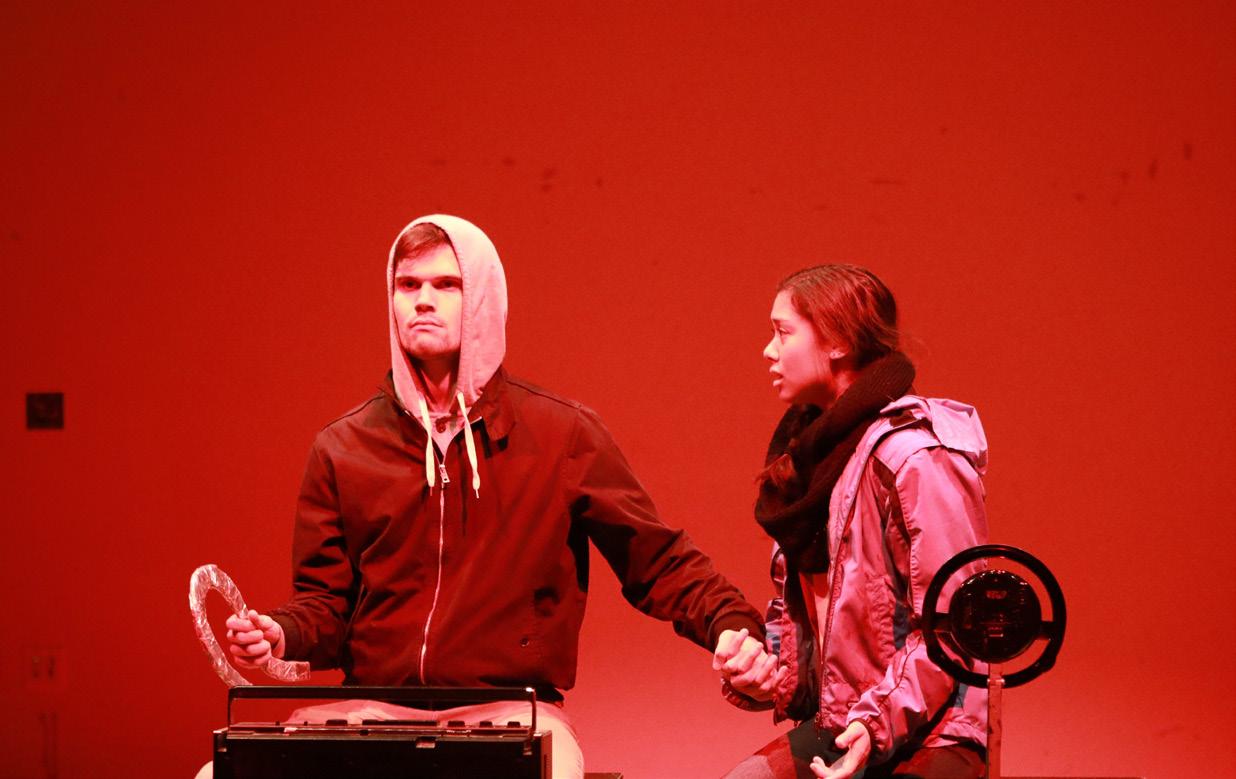
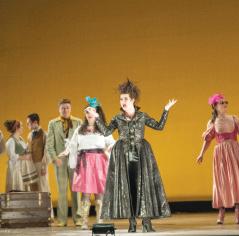
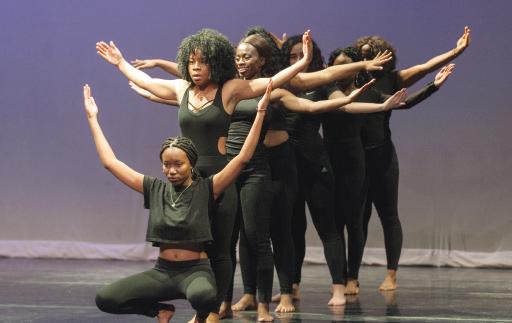
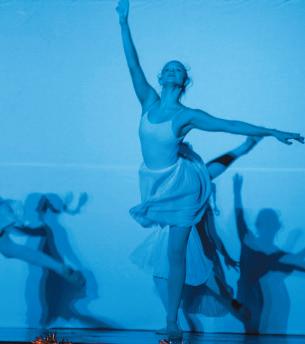


; Catching grammar mistakes redhanded since 1949. Join Copy. Contact Ariella Weiss and Isabel Roseth at copy@thejustice.org ? , . _ ! “ ” : ( ) / ContactHannahKresselat Want to write crosswords for the Justice? Contact Megan Liao at arts@thejustice.org Email Email Jack JackY Yuananw weiChengaeiChengat t photphotos@thejusticos@thejustice e.or.org g Illustration by MORGAN MAYBACK/the JUSTICE; Photos by THU LE/the Justice, NATALIA WIATER/the Justice, YURAN SHI/the Justice, YVETTE SEI/the Justice, CHELSEA MADERA/the Justice. Join Photos! Capture the best parts of campus
DINING: BLU, other students collect over 600 signatures on their petition
dining workers partnered with the Brandeis Leftist Union in a display of student-worker solidarity.
The Sept. 22 delegation began at 2:40 p.m. in Upper Us dan. A member of the BLU led a call-and-response chant with workers on a megaphone, saying “What do we want? Kevintz back! When do we want it? Now!”
In blue shirts and black pants with smiles across many of their faces, dining workers posed for photos with ban ners saying “Reinstate Kevintz” painted in black and blue lettering and “Worker Power Student Power” in blue and red lettering. The group marched down to Har vest Table’s office in Lower Usdan, in an attempt to give Hargrove a petition. The petition included demands to reinstate Kevintz with back pay and was signed by over 600 people. But Hargrove was not there. “They got scared and ran away,” one dining worker remarked, referring to the employees who work in the Office of Hospitality. Though it was not part of the original plan, BLU mem bers and one dining worker decided they would walk in the rain to confront Hargrove at Sherman Dining Hall. Upon arrival, workers at Sherman greeted the demon strators with cheers and encouragement.
Dining workers pointed demonstrators in Hargrove’s direction. Hargrove would not accept the petition. In stead, he speed-walked through the back hallways of Sherman Dining Hall. “Clayton, this petition was signed by over 600 people,” a BLU member shouted, as Har grove’s back was turned to them. But he continued avoid ing them and then disappeared into the kitchens.
BLU members made the trek back up to the Usdan Stu dent Center and scattered when they received word that the Brandeis Police had been called to Sherman. Two University Police officers arrived at Upper Usdan min utes later. According to the Department of Student Rights and Community Standards’ “Rights and Responsibili ties” page, “the University has a responsibility not only to promote a lively and fearless freedom of debate and de liberation, but also to protect that freedom when others attempt to restrict it.” University Police are instructed not to break up protests. According to the Brandeis police
log, upon arriving at Sherman Dining Hall and seeing that no students were there, no further action was taken.
As of Oct. 3, Harvest Table executives have canceled meetings with both the BLU and the Justice. Matthew Carty, the guest experience manager with Harvest Table, whom Justice reporters have been instructed to send all questions to, declined to meet in-person. He instructed reporters to send all questions over email for Harvest Ta ble to review. The Justice reached out to Carty via email on Oct. 3, but did not receive a response at the time of publication.
Despite telling Justice reporters on Tuesday, Sept. 13 that he could meet at 11 a.m. on Sept. 16, Carty canceled the evening before. He said he now had a “conflict in the morning.” When asked for a different time to meet in person, he said, “We appreciate the offer … our time is completely focused on the dining experience – however, please feel free to reach out with written questions.” Since then, Harvest Table has declined repeated requests to meet in person.
Since the University Police were called on Sept. 22, the BLU, which frequently posts information on their Insta gram, posted an infographic detailing their account of the situation as well as their demands. Titled “Harvest Table Executive Calls Police on Students,” the post claims Har grove “called campus police and lied about the reason students were present.” The Justice direct-messaged the BLU Instagram to verify how they knew it was Hargrove who called. “We were notified by someone who spoke to the police after they arrived but will not disclose who the individual was for safety reasons,” they replied. At the time of publication, BLU’s post has received more than 400 likes, and the petition to reinstate Kevintz had over 600 signatures.
Hsiung said she expected that these tensions would happen. “Every time the new company is the same way,” she said. “They need to respect the union,” she added, in reference to Boston Local 26. Regarding Harvest Table’s lack of comment on Merisier’s job status and the events that have subsequently occurred, she said, “If no answer, we’ll be back.”
–Editorial note: Anna Martin contributed to reporting.
ANTHROPOLOGY: Prof. Golden discusses ethical concerns and historical discoveries
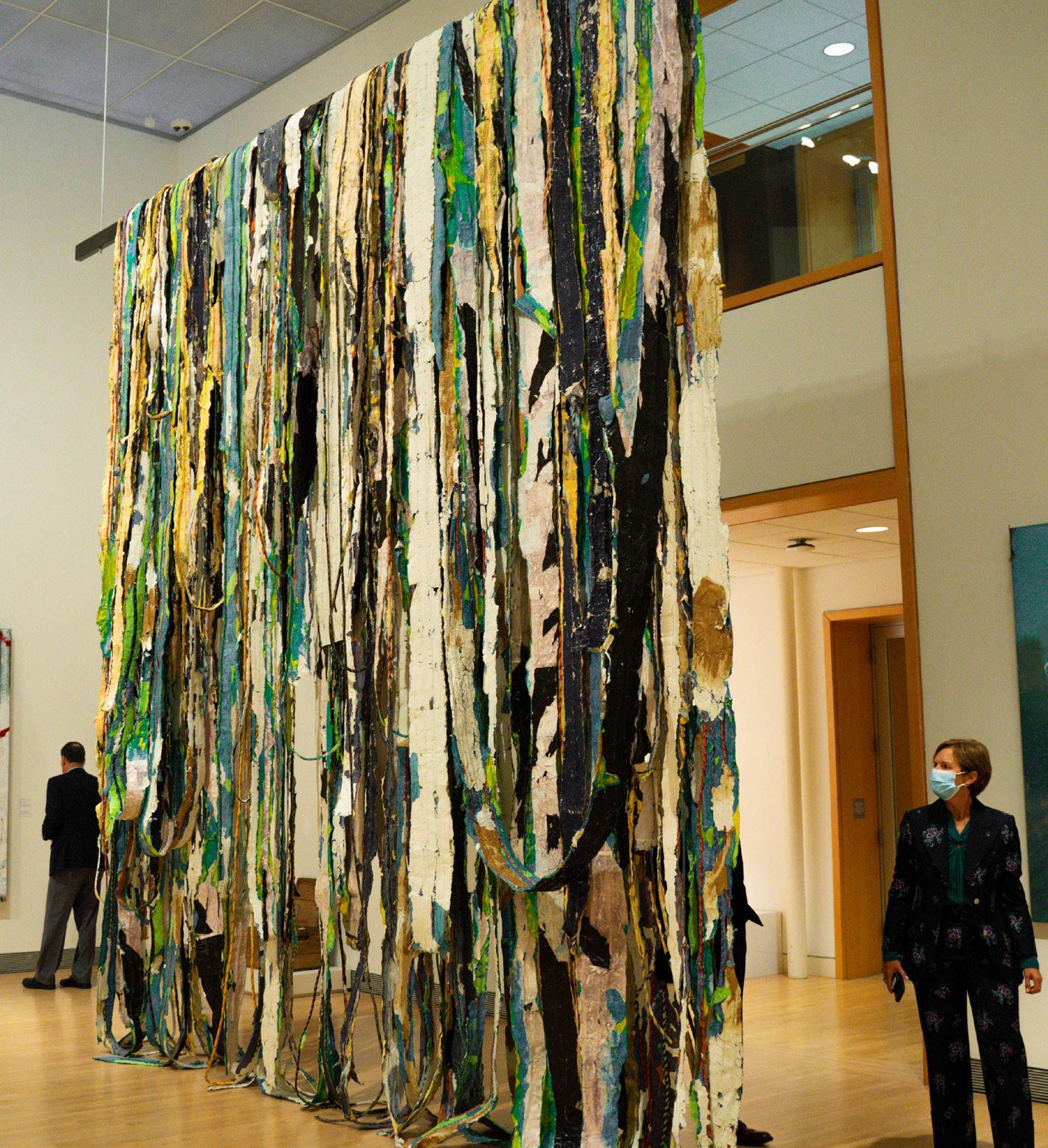
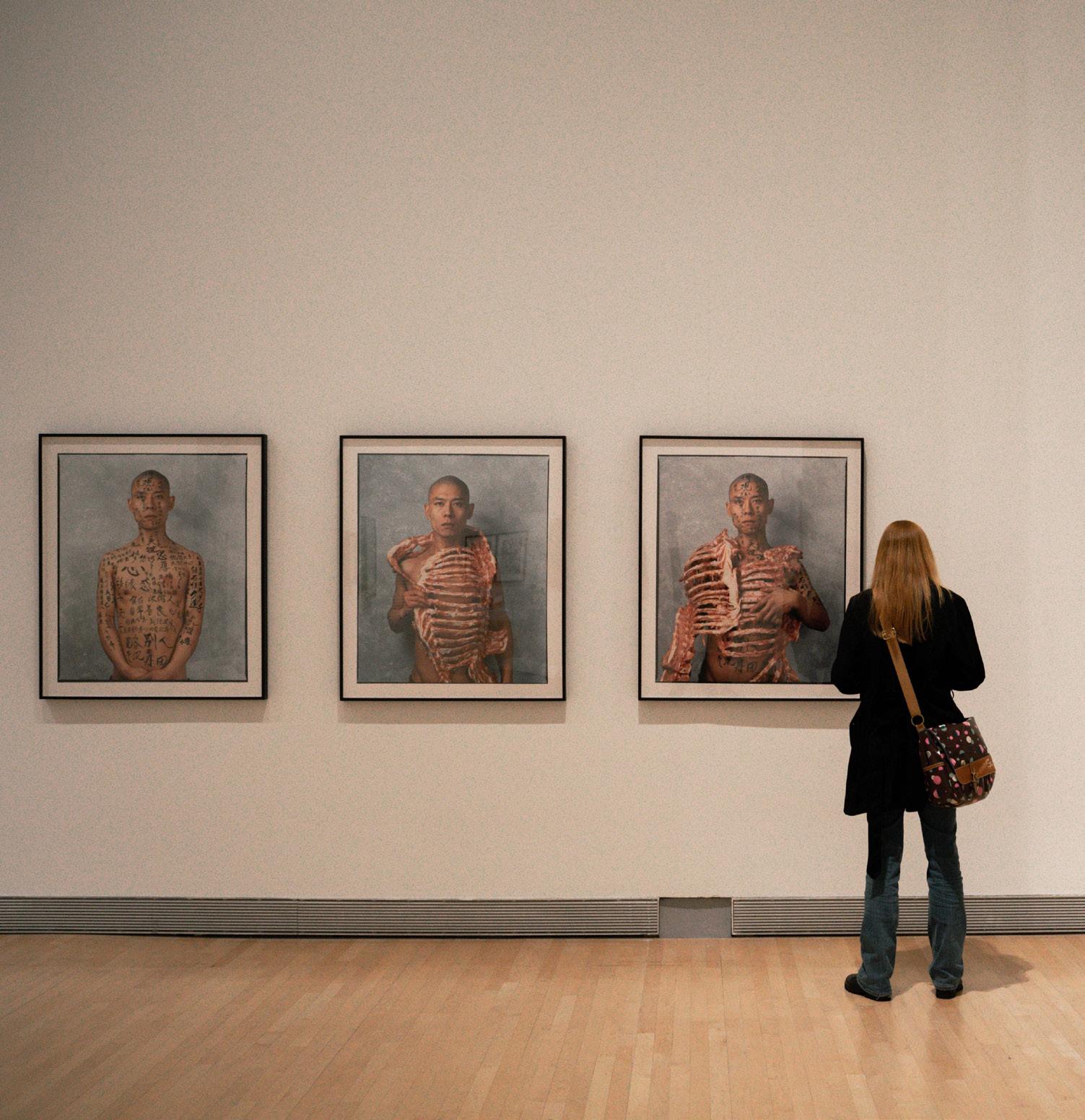
of the excavation site, took much consideration be fore notifying anthropologists about the ruins, due to fears of a heritage being abused, according to the New York Times. But Golden emphasized that these fears are allayed by the active efforts of the researchers to conserve the terrain and history that the individuals who inhabit this region value so deeply.
In addition to the careful excavation practices, Golden shared that he works alongside both local and national authorities, as well as Mexico's Instituto Nacional de Antropologia e Historian. Golden also discussed who he brings along with him to the sites: both Brandeis students Van Kollias (Ph.D.) and un dergraduate Alex Bazarsky ’23 are a part of a younger generation of anthropologists who will utilize these practices that respect and value the history and input of the communities they impact.
Professor Golden reflected on ancient Mayan soci eties and what we can learn from them. He shares that a culture of “conflict, warfare, and climate instabil ity” was as prevalent then as it is in modern times.
The artifacts discovered will remind the public of the Mayan people within our own generation who “speak one of the dozens of Mayan languages in Mexico and Central America,” and by doing so, continue to rein force the permanence of Mayan culture within our society. Discussion with Golden quickly reveals how Mayan people’s way of life influences the decisions we make, this only reinforces how influential and sig nificant his discoveries are.
Golden believes that if we seek insight into our lives today, we must “look to the past for ways that people confronted challenges, thrived, persisted, and transformed.” He reflected that “every small frag ment of broken pottery may be the missing piece” to a history that completes us all. Most significantly, his work is guided by the belief that artifacts teach les sons that become increasingly important “as we look to a world shaped by climate change, internal politi cal discord, and international conflict.”
It became clear that Golden finds it easy “to empa thize with and appreciate” the human past and he be lieves in learning a great deal from the histories and artifacts that continue to be discovered.
CAPSULE : Students able to order prescriptions and medications directly to campus
on Capsule’s end.” Delivery cou riers are also “heavily vetted” by the company and receive training.
“I can understand [mix-ups or lost prescriptions] being a concern, but I really don’t see it being an issue,” Miller said.
Another feature of Capsule that Miller liked and wanted to bring to Brandeis was their lack of de livery fees. Other pharmacies of fer delivery services, but for a fee.
With Capsule, that would not be an issue. “We don’t want access to medications to be cost-prohibitive to any and all students,” Miller said in reference to why Capsule was the “only option” that the Student Union considered. That was the ap peal: the only fee students will have to pay is their usual copay. Every thing else is covered completely by Capsule. Prescriptions can be re ceived from any U.S. state, but in ternational prescriptions cannot be accepted. Non U.S. citizens are still able to take part in the program so long as their prescriptions are from a U.S. provider.
However, campus prescription deliveries, while very important, is not the Union’s end goal. Now that they have created a solution, the Student Union believes that this partnership will serve as a stepping stone to fixing broader issues of ac cessibility at the University.
Miller hopes that it will demon
strate to Brandeis administration “how powerful accessibility can be for a student community” and encourage them to begin taking a more hands-on approach. It can be revolutionary, she said, to provide and care for student wellness, par ticularly when students have long felt that that is not considered a pri ority by those in charge.
In order to inform students about this new initiative, the Student Union is hosting a question and answer session on their Instagram page, @brandeisuniversitysu, on Oct. 4 to answer “any and all ques tions” students may have about the new program.
A kickoff event will also take place on Oct. 13 outside Usdan from 10 a.m. to 3 p.m., with representa tives from both the Student Union and Capsule to help students reg ister and answer their questions. More information can be found on their Instagram page, along with a QR code for students who wish to register.
Miller is proud of what she and the Student Union have achieved together. “Already, I think we’ve seen a lot of students say, ‘This is amazing, this is fantastic. I don’t have to, like, block out half of my day to go into Waltham and get my inhaler anymore,’” she said. Col lege students tend to prefer ser vices that are accessible and conve nient, which Capsule, she noted, is more than able to provide.
Do you have a nose for news? Want the scoop?
Leah Breakstone and Dalya Koller at
 're: collections, Six Decades at the Rose Art Museum' is a new exhibit organized in celebration of the museum's 60th anniversary, with art focused on the past and the future.
're: collections, Six Decades at the Rose Art Museum' is a new exhibit organized in celebration of the museum's 60th anniversary, with art focused on the past and the future.
THE JUSTICE ● NEWS ● TUESDAY, OCTOBER 4, 2022 5 CONTINUED FROM 1
CONTINUED FROM 1
Contact
news@thejustice.org
CONTINUED FROM 1
CECI WANG/the Justice
justfeatures
It’s very important for us all to understand that we are interconnected, and we need to hold hands together, especially when the going gets tough.
ON THIS DAY…
In 1957, the Soviet Union launched Sputnik 1, the first artificial satellite. It orbited Earth until 1958.
FUN FACT
Our galaxy could contain over 100 million black holes. There is a supermassive black hole at the center of the Milky Way called Sagittarius A* that is around 4 million times the mass of the sun.
‘We failed as a nation and were betrayed’: former Afghan diplomat, Heller alum speaks out a year after Afghanistan’s fall
By MESHULAM UNGAR JUSTICE STAFF WRITER
The United States launched its “War on Terror” in 2001, when a U.S.-led military coalition invaded Afghanistan in response to the 9/11 attacks carried out by the global terror ist group al-Qaeda, who were being sheltered in Afghanistan.
On Sept. 20, 2001, former President George W. Bush an nounced the War on Terror, saying, “Our war on terror be gins with al-Qaeda, but it does not end there.” Just over two weeks later, coalition forces began an air campaign against al-Qaeda and Taliban targets. The Taliban — a fundamental ist political movement that harbored al-Qaeda — controlled Afghanistan at the time of the U.S. invasion.
The U.S. and its allies overthrew the Taliban government in December 2001. Less than a year into the war, the Bush Administration began focusing its efforts on setting up a new governing body in Afghanistan. “Peace will be achieved by helping Afghanistan develop its own stable government,” Bush said in an April 2002 speech. The U.S. supported the creation of the Islamic Republic of Afghanistan. Although it was designed as a democratic government, the new system was riddled with corruption.
In August 2021, two weeks before the U.S. withdrew all troops from Afghanistan, the Taliban recaptured the coun try’s major cities, deposing the Islamic Republic of Afghani stan. The Taliban took control of Kabul, the capital of Af ghanistan, on Aug. 15. On Aug. 30, the last U.S. troops left Afghanistan.
Lasting two decades, the war in Afghanistan is the lon gest in American history. Nearly 2,500 American service members died fighting in Afghanistan. At least 46,000 Af ghan civilians have been killed in the war, according to a 2022 report from Brown University, while 3.5 million had been displaced by the end of 2021, according to the United Nations. This number does not take into account “indirect consequences” of the fighting, such as disease and loss of ac cess to food and water. Today, Afghanistan is fully ruled by the Taliban.
Naveed Noormal grew up in Afghanistan. For over 10 years, he devoted his career to supporting his home coun try through diplomacy. He now lives in London and works as a journalist for Volant Media, Afghanistan International. Noormal, a Fulbright Scholar, received his Master’s in Con flict Resolution and Coexistence from the Heller School for Social Policy and Management in 2016. He was originally drawn to the University after hearing a talk by Prof. Alain Lempereur (Heller) while Lempereur was visiting Kabul.
After graduating from the Heller School, Noormal served in the Afghan Deputy Foreign Minister’s office. In late 2017, he was assigned to the Afghan Embassy in London. He first led the consular services section of the Embassy, providing services to Afghans in the United Kingdom and U.K. citizens interested in Afghanistan. He then took on the political en gagement, economic cooperation, and strategic communica tions portfolios, wrapping up his time there in January 2021.

Noormal spoke to the Justice via Zoom March 8, answered follow-up questions via email in August, and provided fur ther updates in September also via email. He spoke about his path to the University, his work in the Afghan Foreign Ministry, and his thoughts on America withdrawing and the Taliban taking over his home country just over one year ago.
The Justice: What did you make of your experience at Brandeis?
Naveed Noormal: When friends ask me this question, I an
swer that if I could live only two years of my academic life, it would be my two at Brandeis. The two years I spent at the Heller School are very close to my heart. It was all I wanted in a school.
TJ: You were serving in the Afghan Embassy in Lon don as the Trump administration negotiated the Doha Agreement with the Taliban. Signed in February 2020 by the Trump Administration, it promised a complete U.S. withdrawal from Afghanistan by May 2021 — later extended to Sept. 11 by President Joe Biden — in ex change for the Taliban not attacking U.S. troops. What did this process look like from your vantage point?
NN: The Doha Process began the weakening of the Afghan Republic. On one hand, the process was leveraged by the Taliban by excluding the relatively stable government in Af ghanistan, and on the other, the government of Afghanistan miscalculated the U.S. support [as] inevitable. The dominant understanding among the government officials was that our allies in the U.S. would not leave us unless a settlement was reached.
TJ: What were you seeing and thinking during the fi nal few months before Afghanistan fell to the Taliban?
NN: I remember in late July 2021, I met former colleagues at the Embassy. We were discussing the situation in Af ghanistan, and we were extremely worried about the fall of provinces, one after the other. Despite the quick fall of the provinces, we thought that if Kabul and a few other prov inces would not collapse, the negotiations would enter a dif ficult stage.
I asked a colleague at the embassy whose mission was end ing, “Are you planning to go back to Kabul at this point or stay in the U.K.?” He told me that if Kabul stays with the government, he’ll go back, but if Kabul falls, then it would no longer be safe. “I don’t think Kabul would ever collapse,” I answered with a smile. I thought that the Taliban were bal ancing their power at the negotiation table with their prog ress in the battlefield and would finally sit and talk about how to share power.
A day after our conversation, we learned that the two im portant provinces of Herat and Nangarhar fell to the Tali ban. At this stage, I realized that we were wrong, and the collapse was inevitable. Finally, on Aug. 15, we learned that Kabul collapsed, and the Taliban entered our capital city. My nation felt betrayed and shattered.
TJ: What did you make of President Ashraf Ghani and his close aides fleeing to Abu Dubai in the final days as the Republic fell? (Ghani was the second and final president of the Islamic Republic of Afghanistan.)
NN: It was painful to hear, especially for people like me who had invested ourselves to public service. We worked tirelessly for these hard-earned values in the past 20 years. The day we heard that the president had left, we felt be trayed, hurt, and that we failed; I am afraid we failed as a nation and were betrayed by our leaders and international partners. This was not only a betrayal of the people of Af ghanistan, but also of the sacrifices in blood and treasure of American and allied soldiers and taxpayers. A lot of souls
were sacrificed to gain and preserve these democratic val ues, and they were vainly compromised.
TJ: In terms of a political settlement with the Tali ban, what did you think it would look like post-Doha?
NN: Before the collapse, there was a consensus in the gov ernment at the regional and international level that there was no military solution, and there would be negotiations to reach a political settlement. However, it was important to reckon with the cost of the settlement. Our understand ing was that the Afghan government and the Taliban would come to an agreement over the type of government, elec tions, constitution, and other essentials; as a result, a powersharing government would be very likely.
TJ: In reality, what happened in those final months from your perspective?
NN: In April 2021, President Biden made it clear that the U.S. wanted out by September 11, 2021. But even then, when they were talking about the withdrawal agreement, we thought that the U.S. would continue to support the Afghan government, at least until a settlement was reached. But that was not the case. U.S. forces withdrew from Bagram Air Field, the largest American base in Afghanistan, overnight and didn’t even bother to let the Afghan government know about it. This decision immensely affected the morale of our soldiers in the battlefield at that time.
I agree that a lot of responsibility goes on the shoulders of the Afghan politicians, who could not create a political consensus in a time of crisis in Afghanistan. However, the international community and our strategic partners share equal responsibility for not listening to the will of the Af ghan people. We, the Afghans, lost a huge opportunity to work for the better future of our country, and together with our partners, we lost a bigger opportunity to avoid the po tential risk of regional instability that could threaten global security in the long run.
TJ: Do you think you have a role in the future of Af ghanistan?
NN: I would love to and hope to return to Afghanistan. However, to be able to serve Afghanistan once again from within the government, it must be a government that re spects democratic values, international human rights, and recognition by the people of Afghanistan and the interna tional community. This will happen, and I believe and have hopes that my future belongs to Afghanistan.
For the future to look better, international engagement is paramount to pressure the Taliban to come to an agreement with all the parties involved in Afghanistan and establish a government that reflects the will of all the people of Afghani stan.
Design: Natalie Kahn/the Justice
After a 20-year military presence in Afghanistan, the United States withdrew its last troops from the country in August 2021. The Justice spoke with former Afghan diplomat Naveed Noormal H ’16 to learn more about Afghanistan’s complicated modern history.
This interview has been edited for length and clarity. The views expressed here are solely those of the interviewee.
Photo courtesy of BRANDEIS UNIVERSITY
Naveed
student
Design: Anna Martin
VERBATIM | MICHELLE YEOH
6 TUESDAY, OCTOBER 4, 2022 ● FEATURES ● THE JUSTICE
SPEAKER:
Noormal delivered the graduate
commencement speech at the 2016 commencement ceremony.
and Ceci Chen/the Justice
SEE YOU IN THE PIT
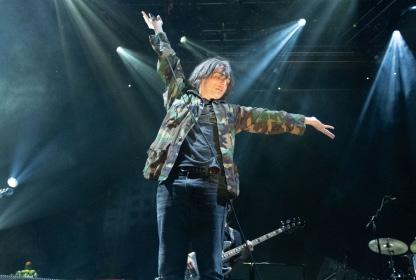
The pandemic brought the Boston area’s active live music scene to a grinding halt. Over the past year, local venues have gradually reopened as artists went back on the road. Students shared their concert photos and experiences with the Justice.

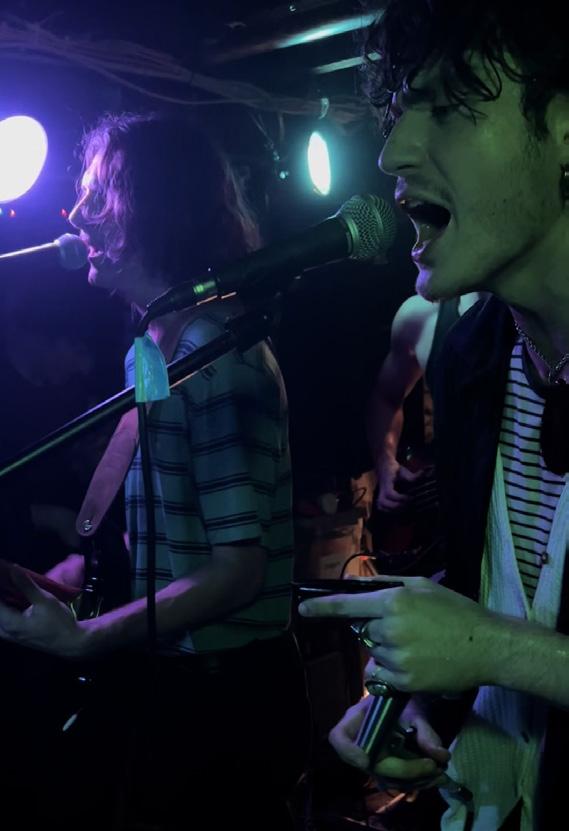



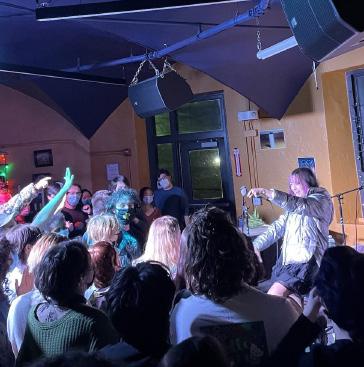



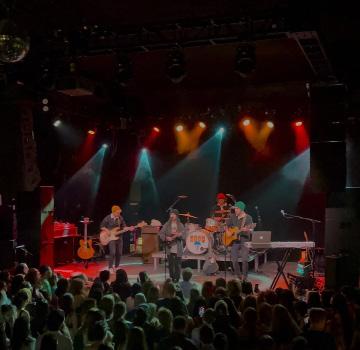

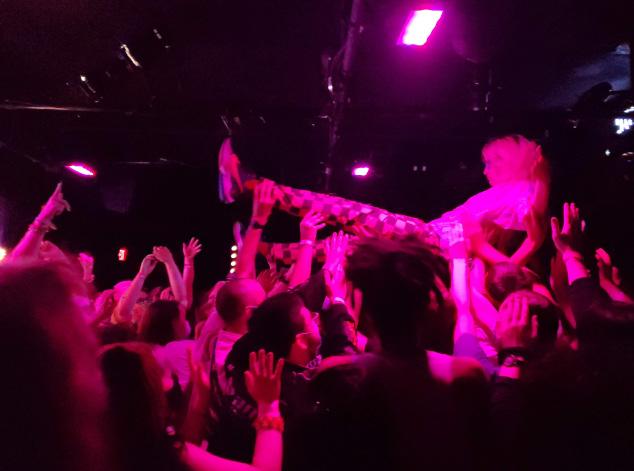
“I love live music so much. When you’re at a concert, you have to be in the moment

it’s a very visceral experience. There’s simply no better high than a concert high.”
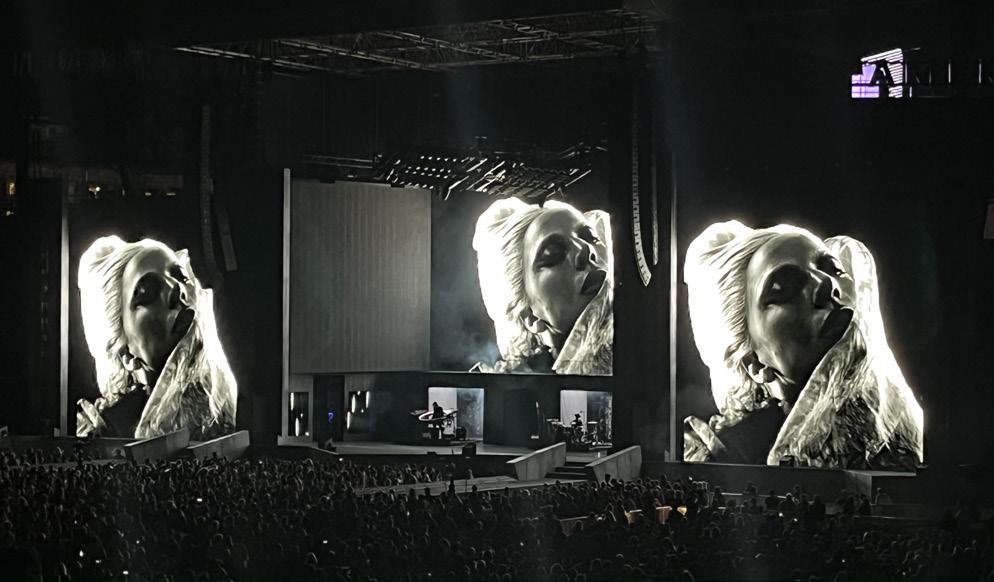

Flautt
“I really valued being able to hear songs that were so important to me when I was younger performed live, when I thought I never would. That experience caused me to reflect a lot on what the band means to me and how I have grown with them.
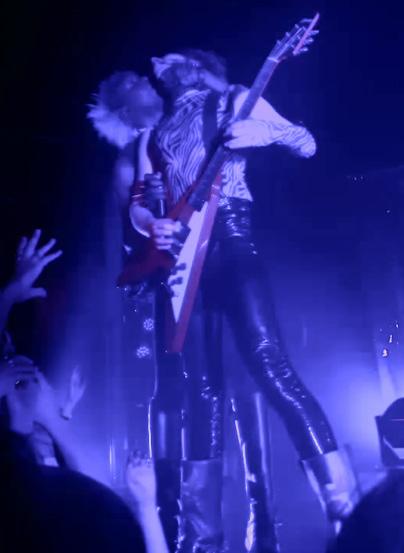
Popovic
“The Lowell scene is a genuine community.
Once you go to one show,

in.
impossible to not feel like you’re
of it, even as a spectator.
every week,
help but
know
the same guys
the houses have this vibrant energy to them.
Design: Anna Martin and Ceci Chen/the Justice
Photo
THE JUSTICE ● FEATURES ● TUESDAY, OCTOBER 4, 2022 7
—
— Jane
’23
— Zoe
’23
…
you’re
It’s
part
… I
it’s
playing
but
I can’t
go — I’m in it now.” — Aileen Cahil ’23 SARA KAYS: June 4, 2022 at the Sinclair ANNA MARTIN/the Justice ONE REPUBLIC: July 19, 2022 at the Xfinity Center JAPANESE BREAKFAST: Sept. 22, 2022 at Roadrunner Photo courtesy of JILLIAN FRIEDMAN SUPERORGANISM: Oct. 1, 2022 at Paradise Rock Club Photo courtesy of ZOE POPOVIC FAYE WEBSTER: Aug. 19, 2022 at Royale JANE FLAUTT/the Justice BEACH BUNNY: Nov 9, 2022 at Paradise Rock Club Photo courtesy of ELLIS ZEHNDER MY CHEMICAL ROMANCE: Sept. 8, 2022 at TD Garden Photo courtesy of ZOE POPOVIC YVES TUMOR: April 3, 2022 at Royale NATALIE KAHN/the Justice PORTUGAL THE MAN: April 14, 2022 at Agganis Arena
courtesy of NOAH RISLEY DESTROY BOYS: June 3, 2022 at The Crystal Ballroom Photo courtesy of SIDONIA OHRINGER MANNEQUIN PUSSY: Oct. 27, 2021 at The Sinclair NATALIE KAHN/the Justice LADY GAGA: Aug. 19, 2022 at Fenway Park NATALIE KAHN/the Justice FRAXIOM: Nov. 7, 2021 at ONCE Photo courtesy of ELLIS ZEHNDER CARLY RAE JEPSEN: Sept. 26, 2022 at Roadrunner CAMERON CUSHING/the Justice DREAMER ISIOMA: Sept. 15, 2021 at Roadrunner NATALIE KAHN/the Justice ANNA MARTIN/the Justice “Nothing is better than the energy of live music!” — Anna Martin ’26 By NATALIE KAHN JUSTICE EDITOR KERO KERO BONITO: Dec. 8, 2021 at Cholmondeley’s Coffeehouse Photo courtesy of WBRS HOUSE SHOWS: Local bands in Lowell perform in large houses, where many band members also live. Photos courtesy of AILEEN CAHILL
Justicethe
Jen Crystal, Editor in Chief
Jane Flautt, Managing Editor
Cameron Cushing and Sofia Gonzalez, Senior Editors
Leeza Barstein, Juliana Giacone, and Hannah Taylor, Associate Editors
Dalya Koller, Leah Breakstone, News Editors
Natalie Kahn, Features Editor
Lauryn Williams, Forum Editor
Megan liao, Arts & Culture Editor
Jack Yuanwei Cheng, Photography Editor
Ariella Weiss, Isabel roseth, Copy Editors
Samantha Goldman, Devon Sandler, Online Editors
EDITORIALS
The importance of student employment
Student employment is incredibly vital to the functionality of Brandeis campus. Our Brandeis University Medical Corps service is a student-run, volunteer emergency group that provides medical attention to the Brandeis community. In addition, the BranVan is a student-run shuttle service that helps students, faculty, and staff to different parts of campus and Waltham. Our student research positions also serve as a great help to our community and faculty as researchers further along and contribute to academic projects and shape the curriculum of future class courses. Students can generally apply for these jobs through Workday, but the application process varies. Those with work study are given priority for the first month of the fall semester.
Brandeis advertises that it has over 200 student-run clubs and organizations. However, a large majority of students within organizations are not adequately compensated.
The services provided by these and countless other organizations are crucial to the well-being of the student body. While the students that join these organizations are enthusiastic about helping others and happily offer these services without financial compensation, it is not sustainable or realistic for full-time students to volunteer a significant amount of time to multiple clubs for services that would be compensated in other settings. This is especially an issue for students who have to make a decision between working a part-time job or volunteering in order to meet financial goals. Last year, the Student Union approved a student leader payment program, where four secured clubs — BEMCo, Waltham Group, the Student Sexuality Information Service, and the Union — were given yearly stipends to pay certain e-board members starting fall 2022. “Funding for the $50,200 total per year payments will come from the Student Accessibility Fund, specifically from skimming the ‘off-the-top’ funding category,” per a Feb. 2022 Justice article. This board applauds the steps taken by the Student Union to ensure student pay within clubs and asks that the University administration be more involved in this process.
Uncompensated work extends beyond student-run clubs and organizations. In the academic setting, the policies across different research laboratories vary significantly in regards to pay. Some students get paid for doing research, while others must volunteer their time and get paid only for doing additional tasks around the lab. As of October 2021, the Undergraduate Research and Creative Collaborations approved new guidelines for undergraduate research participation. “In normal circumstances, students should either be paid or should receive academic credit for independent research,” the guidelines state, “In exceptional circumstances, students may petition to be allowed to volunteer outside of the employment and course structure for a period of up to 4 months.” Exceptional circumstances include starting research in the middle of a semester and working during the summer if funding is unavailable, per the website. Credit for research is usually
in the form of a one credit class, except for those doing a senior thesis, who receive four credits.
This board commends the URCC for working to ensure that students involved in research are compensated—either through class credit or pay—for their work. However, this board questions whether one credit is enough for the amount of work students devote to research. While we understand that the one credit option is convenient for students who need to take 22 credits worth of classes, one course credit is not equivalent to what students would be paid if payment was the only option for principal investigators. This board also sees an issue with the implementation of these guidelines. Has the University developed a system to keep track of all students involved in research? Are there consequences for faculty who fail to follow these guidelines?
The current system, both at the academic and volunteer level, relies heavily on students’ enthusiasm and passion. However, it also amplifies disparities within the Brandeis community, since only students who can afford to volunteer parttime can join certain clubs, organizations, and research labs. Work-study, though included in many students’ financial aid packages and a selling point for prospective students, often goes unfulfilled. Work-study, according to the Office of Student Financial Services, is a work program funded by Brandeis and the federal government which is awarded to domestic undergraduate students. Under this program students can work at an on-campus department or an approved off-campus community service agency.

However, there has been an ongoing problem for students who wish to fulfill their work study requirements. In the article “Work-Study, but no work?” written by Mirabell Rowland, she notes that just because one qualifies for student WorkStudy does not mean they are guaranteed an on-campus job.
That much is evident, in an interview with a Brandeis student, Rubaiya Nasim ’23, she details her experience with not being able to secure a job despite being a part of the Work -Study program.
Nasim states that “Work-Study jobs are somehow way more competitive than I thought they would be. Sometimes you’d receive a letter rejecting you, but at times some departments didn’t even send a notice.” The lack of job accessibility for students on campus can lead to unforeseen financial hardships and an increase of pressure on students to stay afloat during the busy school year.
This board calls on the University to increase the number of jobs available for students, so that those with financial aid can fulfill their package, particularly as larger first-year classes increase the demand for on-campus jobs.
—Editor’s note: Editor Jack Yuanwei Cheng ’23 and the Undergraduate Research Creative Collective;
Editor Natalie Kahn ’23 is a volunteer for Brandeis University Medical Corps. They did not contribute to or edit those parts of the article, pertaining to those organizations.
Asking for a friend
Q: How can students practice sustainability on campus?
A: The fantastic local organization Rare has iden tified the highest-impact behaviors that Americans can adopt to reduce their greenhouse gas emission signifi cantly. If an additional 10 percent of Americans adopt these behaviors, it will reduce U.S. emissions expo nentially —by nearly as much as the combined annual emissions from New York, Los Angeles, and Chicago (the three largest U.S. metro areas). These behaviors are geared toward the general (non-student) population:.
• Food: Eat more veggies and cut food waste
• Energy: Switch to clean energy;
• Transportation: Drive an electric car & fly less
• Protect nature by donating to nature conservation. However, some of these are not very accessible to stu dents. That’s why we recommend the following for stu dents on campus, which we have outlined in our “Green Pledge”. Just like Rare says, definitely eat more plantbased foods and cut your food waste. Use your voice. Advocate for sustainability policies (we are supporting this through our Climate Organizer-in-Residence action dinner series starting in October), and discuss climate change with friends and family. A recent study led by Yale researchers found that simply discussing the cli mate crisis with friends and family leads to greater un derstanding and concern about the issue. Make climate your career. Whatever your major and career path, you can find a way to take climate action through any job.
We will be working with Hiatt next semester to bring several events related to making your career — in whatever field you choose — contribute to climate ac tion. One other easy change is to wash your clothes in cold water. Heating water uses a lot of energy! Brandeis students do roughly 34,000 loads of laundry on campus every year. If all of those cycles were done using cold wa ter, which uses about 50 percent less energy, we would avoid about 100,000 pounds of carbon per year, about the same footprint as one entire residence hall.
We hope that participating in our Year of Climate Ac tion events will inspire many more ideas.
The Office of Sustainability
JACK YUANWEI CHENG/the Justice
Established 1949 8 TUESDAY, OCTOBER 4, 2022 ● FORUM ● THE JUSTICE
Brandeis University
—
Not My Average Autumn: from California to New England
By TASHA EPSTEIN JUSTICE STAFF WRITER
For once, I can understand why fall is some folks’ favorite season.
See, my hometown is a dense suburbia in the Bay Area of California where the seasons vary between “warm and sunny,” “chilly and wet,” and “actively on fire.”
Fire season typically runs from February through the following February, but the worst months are those in the fall. Typi cally, we’d have rain to help keep wild fires at bay, but due to climate change, our chilly, wet season has been pushed back and the dry brush from warm and sunny season dies off to become kindling.
Thus, I associate fall not with woodsmoke and apple cider, but rather wildfire smoke and CAL FIRE alerts. There were days when the sky turned orange and rained bits of ash, like some dystopian young adult novel’s nuclear winter. Once I was driving up to the city to see a friend and got red fire retardant on my windshield as a low flying plane opened its reserves over the highway for the wildfire alongside the frontage road. If you don’t think about the horrifying contexts of those experiences, they’re ac tually pretty cool!
But, New England fall makes all that autumn romanticism make sense. I’m no fool — I’ve heard tales of the beauty of New England autumns; I’ve just never
actually experienced any. Getting to ac tually see the leaves change and drink real apple cider is incredible. I’ve read plenty of books involving New England scenery; I’m a huge fan of old, classic hor ror. I never “got” the lines about rain and fog amidst swirling crispy leaves and the scent of woodsmoke in the air. Califor nia could barely get a “dark and stormy night.”
My friends have been thoroughly be mused, and at times concerned, about how little I seem to understand New England … and perhaps, seasons. I was absolutely thrilled by the snow that I got to see in January of last year — midyear admit — and spent a good while bouncing around excitedly. Somehow, I never fully processed that snow, being frozen water, was cold and nearly gave myself frostbite on my hands.
Similarly, September in my hometown isn’t something I’d call a “cold” month. Looking up the weather report for my area, this week is apparently in the mideighties back home. So you can imagine my surprise when I left my dorm in a sun dress, only to discover it was 60 degrees out: a positively frigid temperature for yours truly. A friend dug a hoodie out of their bag with a sigh and chastised me lightly for assuming the fact it was sunny out meant it would still be warm.
I digress — besides the cold, the weath er and environment here is absolutely
delightful. We don’t have chipmunks in my area, and I was entirely captivated by them upon getting to Brandeis. It’s also incredible to watch the colors change in the world. Boston has these deep hues of green that turn to yellows, oranges, and reds, while California seems to have a fairly universal shade of beige or taupe. Less rain means less green, I suppose.
Halloween and Thanksgiving also seem like much better holidays now. Don’t get me wrong, I liked them fine — I just never “got” them.
As a kid, I’d overheat in my Halloween costume if the fabric was too heavy or the sleeves too long; here, I can be cold no matter what jacket I’ve got on. I’ve actu ally had to buy heavier clothes — I nev er had a rain jacket or heavy coat back home; I’ve never needed them and having them just seemed impractical. However, one or two good storms have since shown me the error of my ways.
To my other friends from warmer states — dress warmly and drink the cider. The overcast skies are depressingly grey, so make sure to take care of yourselves! Fall hits differently in this state but so does seasonal depression. I’ve found that soft, cozy blankets and hot beverages are quite pleasing.
Overall, despite the fact that I’m con stantly shivering, I’m very excited to be experiencing my first real fall. The leaves are changing, and I can smell the occa
sional whiff of woodsmoke. It’s no longer fire season or just “summer, but with school this time.” This is autumn, and I’m eager to experience it fully. Now, if you’ll excuse me, I have to go peer pressure my friends into accompanying me apple pick ing.
Why the lack of accessibility on Brandeis’s campus is detrimental
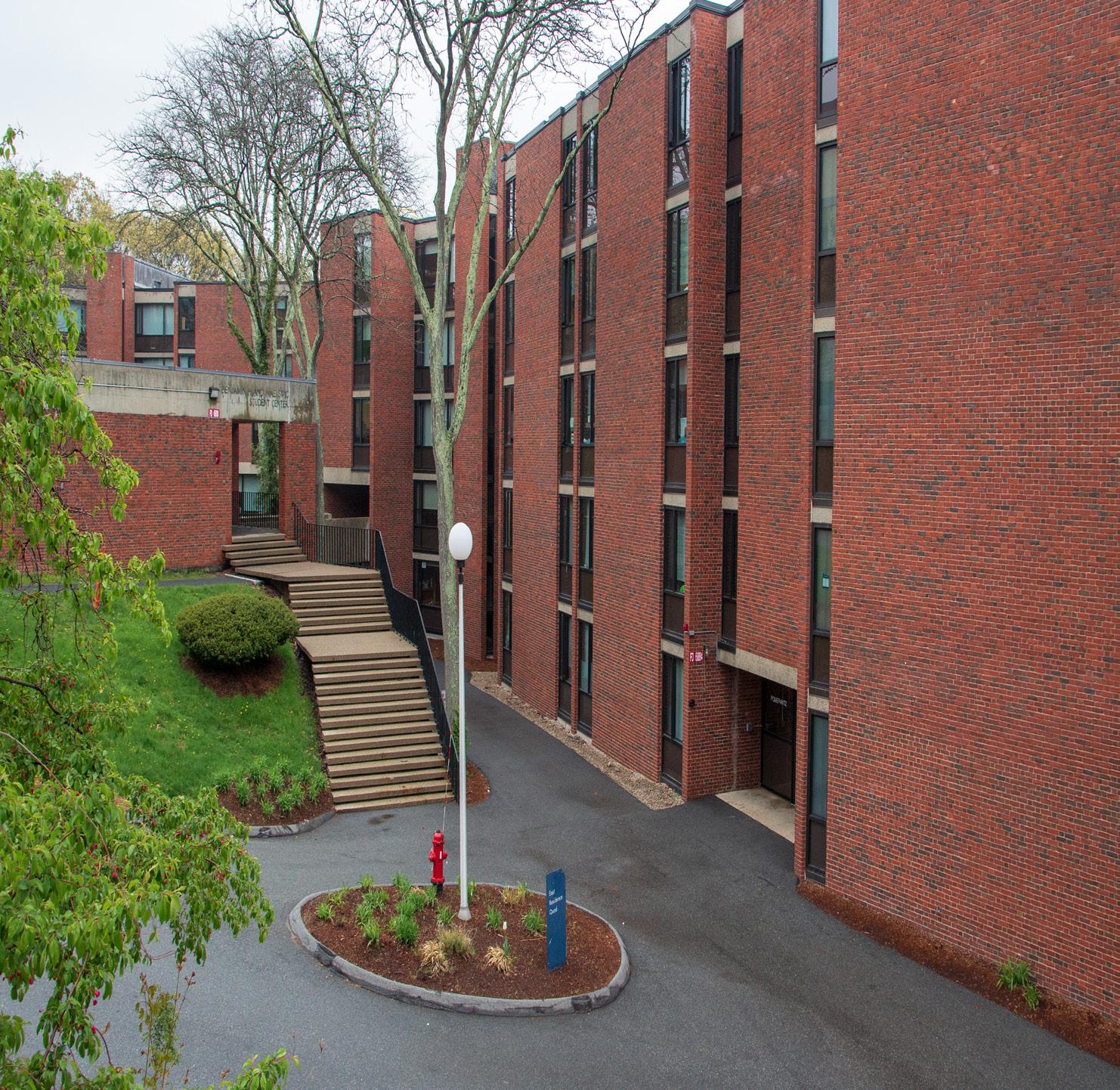
 By SKYE LIU JUSTICE CONTRIBUTING WRITER
By SKYE LIU JUSTICE CONTRIBUTING WRITER
Born with a rather aggressive form of developmental dislocation of the hip, my life has always been filled with surgeries and “mild” inconveniences. Surgeons were able to patch me up with six surgeries, and I can walk almost like everyone else for short distances, except for one problem: stairs.
Growing up, my schools have always been very accommodating, plus all I really needed was an elevator pass. However, when I arrived at the University, things became a little more challenging. Before school started, I researched my accommodations options on campus just like I always did. I got all my medical letters translated, filled all the forms as the Student Accessibility Services website indicated, and submitted my housing accommodations request three months before school started.
To my suprise, I found out that I was assigned to the second floor of a building without an elevator. I initially thought that “this must be the best they could do,” and I went with it.
As a handicapped person who also happens to be an international student without family members to help me with moving, it was a pretty difficult process with a lot of physical pain on my hip. Again, nothing undoable; I knew there were people who had it worse than me, so I didn’t complain about it.
Two months after the initial movein, I found an email in my mailbox from housing stating that they just saw my housing accommodation and asking me if I would like to be switched to the ground floor. I was sitting in my room, surrounded by all the pieces of furniture I had spent hours moving up the stairs and into the room while reading that email. I thought about it and decided to not go through the hassle again.
My several encounters with SAS didn’t make my decision to move off campus to a building with elevators that difficult,
and having a car was essential since my apartment was not within walking distance to a BranVan station, so I began looking into the parking accommodations at Brandeis. The website of Disability Accommodations in Campus Housing wrote: “Regardless of accommodations, all students must obtain a parking permit from the Parking Office. This includes students with DOT disability placards.”
This statement really threw me off, as I never had to pay for having a disability in the past. I thought this must have been some sort of a mistake, but my several visits to the Parking Office confirmed that I was not mistaken — I do have to pay for a parking permit, even with a stateissued handicap placard. As it turned out, I did not have to pay to get my doctor’s letter of diagnosis, did not have to pay for a handicap placard from the state of Massachusetts, did not have to pay for parking meters in the entire state, but had to pay for parking at my own school.
I remember researching Brandeis and reading the webpage of the Diversity, Equity & Inclusion Office when I was a senior in high school: “We are committed to working collaboratively with our campus community to build high-quality programming that brings about positive and equitable social change.” Diversity and inclusion are big things for me when it comes to deciding where I work and study, so I have always taken pride in being a student of an institution that embraces them. But is this still an equitable campus if people have to pay to live an equitable life here?
Their rationale for this is that it was my choice to have a vehicle on campus, and they do have an accessible transport van, the BranVan, on campus that I chose not to use.
Don’t get me wrong, I think having the van is great, but the problem is that you have to pre-plan your pickup and drop off locations a week or two ahead of time.
That does not allow any room for flexibility, and the communication is via email, which never hides the names of
the recipients, so I can see a list of every single person who is handicapped on campus. I don’t really mind that, as I am very open about my physical condition, but I always wondered if everyone else on the recipient list would feel the same way that I do. Of the several people I know who receive the van service, none have ever used it because the amount of planning and communication that went into getting one ride from North Quad to the Usdan Student Center was simply not worth it.
I am someone who is extremely lucky to have support to pay for my tuition, offcampus housing, and parking on campus. My physical condition also allows me to live only mildly inconveniently, even without the accommodations I need sometimes.
However, I know I have peers on the very same campus needing those same accommodations much more than I do, and they deserve the equity without having to pay for it.
The Justice welcomes letters to the editor responding to published material. Please submit letters through our Web site at www.thejustice.org.
Anonymous submissions cannot be accepted. Letters should not exceed 300 words, and may be edited for space, style, grammar, spelling, libel and clarity, and must relate to material published in the Justice.
to us
Letters from off-campus sources should include location. The Justice does not print letters to the editor and op-ed submissions that have been submitted to other publications. Op-ed submissions of general interest to the University community — that do not respond explicitly to articles printed in the Justice — are also welcome and should be limited to 800 words. All submissions are due Friday at noon.
Fine Print The Staff
The opinions stated in the editorial(s) under the masthead on the opposing page represent the opinion of a majority of the voting members of the editorial board; all other articles, columns, comics and advertisements do not necessarily.
The Justice is the independent student newspaper of Brandeis University. Operated, written, produced and published entirely by students, the Justice includes news, features, arts, opinion and sports articles of interest to approximately 3,500 undergraduates, 900 graduate students, 500 faculty and 1,000 administrative staff.
The Justice is published every Tuesday of the academic year with the exception of examination and vacation periods.
Advertising deadlines: All insertion orders and advertising copy must be received by the Justice no later than 5 p.m. on the Thursday preceding the date of publication.
All advertising copy is subject to approval of the editor in chief and the managing and advertising editors.
For information on joining the Justice, write to editor@ thejustice.org.
The opinions expressed on this page are those of each article’s respective author and do not reflect the viewpoint of the Justice.
Justice
photo
JACK YUANWEI CHENG/the Justice
Write
THE JUSTICE ● FORUM ● TUESDAY, OCTOBER 4, 2022 9
Editorial assistants Photography: Owen Chan, Smiley Huynh Sports Aiden Guthro Online: Eden Osiason, Zachary Goldstein Features: Cayeen Landau s News: Amanda Chen, Isabel Roseth, Max Feigelson, Sydeny Duncan Features: Leah Breakstone, Cayenn Landau, Isabel Roseth, Maddy Dulong Mirabell Rowland Forum: Abigail Cumberbatch*, Tibria Brown, Tasha Epstein Sports: Zach Goldstein, Prateek Kanmadikar, Jackson Wu, Aki Yamaguchi Arts & Culture: Vicente Cayuela, Amy Chen, Miranda Sullivan Photography: Thomas Tiancheng Zheng Copy: Daniela Zavlun, Nataniela Zavlun Graphic Design: Emily Braun, Sara Fulton, Yuan Jiang, Shinji Rho, Grace Sun Online: Amanda Chen * denotes a senior staff member.
file
NBA: LeBron James closes in on scoring r ecord
CONTINUED FROM 12
known throughout the sports world, with some calling it the greatest rivalry in the NBA. Its intensity has lessened since the retirements of Magic Johnson and Larry Bird. However, as long as LeBron is still with the Lakers, it’s clear that this




rivalry between Los Angeles and Boston will remain relevant in the world of the NBA. Regardless of these external factors, James has the chance to rewrite basketball history forever.
WNBA: Gray named Finals
CONTINUED FROM 12
won a championship, now it’s time to step up.’”
By looking at what the franchise has done, anyone could tell that a trophy was on the horizon. After Mark Davis, also the owner of Las Vegas Raiders, purchased the team in 2018 and moved it to Las Vegas, he has made constant investments into women’s sports.
He announced the establishment of a 80,000-square-foot training and administrative complex soon after the purchase and hired two successful Black female frontoffice executives: President Fargas and General Manager Natalie Williams, and the first WNBA coach with a million-dollar salary, Coach Hammon. He also voices support for raising stream revenues and elevating the salary structure to keep the players home during the offseason. With the championship on the line, Davis decided to attend game four of the WNBA finals instead of the Raiders’ game that night to show his support. The Aces made his decision well worth it.
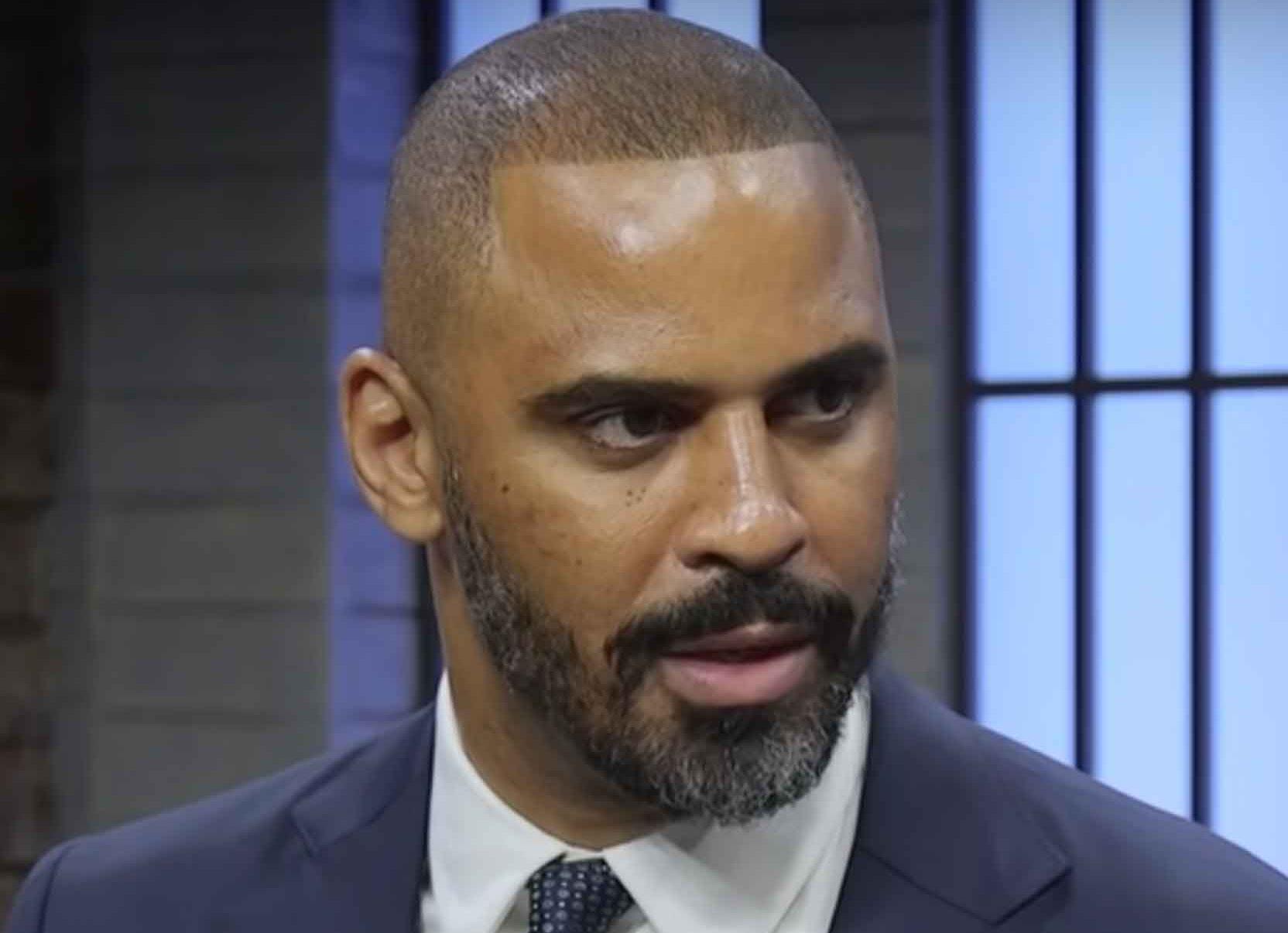
The 2022 season marks a year of incredible accomplishments for the WNBA, as well. WNBA
MVPCommissioner Cathy Engelbert has made pivotal decisions to “prioritize marketing and merchandising, while looking hard at expansion, sports gambling and partnerships.” The league also adjusted its postseason schedule to accommodate the World Cup’s schedule for women’s basketball, resulting in a smaller overlap with the National Football League’s season. While the finals’ viewership took a little hit due to the overlap, the postseason’s viewership has grown a significant 22 percent compared to last year and has become the most-viewed playoffs since 2007. Even though the denser schedule had led to some backlash surrounding the increase of players’ injuries and lack of days off, the introduction of charter flights in this year’s finals did compensate the players in some way. The WNBA has recently announced plans to expand its regular season into 40 games with rumors of adding new franchises to the league. The future of the league looks bright, as both examples from Davis and Engelbert have shown that success will follow with investments in women's sports.
CELTICS: Celtics face setbacks as new season looms near
FROM 12
further evaluation by team doctors. Set to be a scoring spark plug off the bench for the team, Gallinari’s debut will have to wait much longer than expected. However, the Celtics are hopeful Gallinari may be able to return near the end of the season if recovery goes well.
Free-agent veteran forward Blake Griffin signed a one-year contract
on Sept. 30. A possible attempt to bolster their injury ridden roster, the Celtics will seek to utilize Griffin’s experience and physicality in their frontcourt. Despite not being the player he formerly was, Griffin provides valuable depth to this roster that was already lacking in size. The six time all-star will play in pursuit of his first NBA championship.
Following last season's finals, Sportsbooks had the Celtics as
the odds-on favorite to win the championship. However, after news broke about their setbacks, betting lines were updated, and the team slipped out of the first position.
As the upcoming season is on the horizon, the Celtics will look to play through this adversity and carry on where business left off. Their first regular season game is scheduled for Oct. 18 at home against the Philadelphia 76ers.
Photo courtesy of CREATIVE COMMONS
GREATNESS: LeBron James enters the 2022-23 season only 1326 points behind Kareem Abdul-Jabbar's NBA scoring title.
Photo courtesy of CREATIVE COMMONS
UDOKA: Former Head Coach Ime Udoka is set to watch the Green from the sidelines following his year-long suspension.
CONTINUED
AGING LIKE FINE WINE Contact sports@ thejustice.org Want to be more than just a spectator? Write for Sports! Images courtesy of Creative Commons
@theJustice Follow theJustice! Image courtesy of CREATIVE COMMONS 10 TUESDAY, OCTOBER 4, 2022 ● SPORTS ● THE JUSTICE
Judges fall to Spartans in conference play
■ The men’s and women’s soccer teams fell short in the UAA Weekend Opener.
By AKI YAMAGUCHI JUSTICE STAFF WRITER
The University Athletic Association conference play opened up this past weekend with the Brandeis Judges traveling to Case Western Reserve University in Cleveland, Ohio. The men’s soccer team was unable to find any offensive ground when they went down a man early in the game after a red card in the 20th minute. They entered the game with a record of 4-2-2 overall, 0-0 in the conference.
The six-match win streak by the Judges women’s soccer team was finally broken in a close game with the Spartans after a late gamewinner. The Judges entered the match 6-2-1 overall, 0-0 conference play.
Men’s Soccer Judges 0, Spartans 4
As a result of playing with 10 men for the majority of the game, there were few offensive chances on the Judges’ part in their game against the Spartans. The extra man on the Spartan side overwhelmed the Judges’ defense, and they were unable to find the back of the net, with only one shot on goal against CWRU.
The Spartans had their first goal from a one-time shot by Adrian Harkness in the 19th minute. Only
a minute later, Brandeis lost a player for the rest of the match when Nick Dunstan-Maiese ’25 received his second yellow of the game. This opened up the match for an offensive push from the Spartans, and they scored again in the 26th minute off a long shot that had an awkward bounce, going past the hands of goalie Aiden Guthro ’23.
The second half was dominated by the Spartans, and they secured their win with two more goals in the 62nd and 73rd minutes. The Spartans held the advantage in shots over the Judges, putting the shot count at 18-4. The Judges will look to recover against MIT on home turf on Wednesday, Oct. 5, at 7:30 p.m. before playing Carnegie Mellon in the Homecoming and UAA home opener match on Saturday, Oct. 8, at 11 a.m.
Women’s Soccer Judges 1, Spartans 2



Entering against the undefeated Spartans, the Judges headed into a challenging game in their first UAA conference game. There was even play throughout the game, but the Judges were unable to hold off the Spartan attack. Brandeis held the advantage for the first half but CWRU pushed back in the second.
The first half remained scoreless with the Judges out-shooting CWRU 5-3. The Spartans were the first to score in the second half when they capitalized on a corner kick. In the 60th minute, a service that was headed in the box found the back of the net with a shot
by Spartan Carolyn Koutures. However, the Judges roared back in the 79th minute when a long ball found the feet of Juliette Carreiro ’23. Caroline Swan ’23 found Carreiro at the top of the 18-yard box who beat the Spartan goalie with a chip shot.
However, the Spartans were able to put a ball past the Judges off a free kick in the 83rd minute. A foul was called just outside of the 18-yard box, with Spartan player Aniya Hartzler stepping up to the ball. She was able to slide it past defenders to the near post, and Judges goalie Hannah Bassan ’25 was unable to get a hand on it as she dove. The Spartans outshot the Judges in the second half 8-4, and finished the match 11-9 in shots against Brandeis. They were also able to capitalize on the corners as their first goal came off a corner kick, and CWRU led 7-4 over the Judges in corners. The Judges will look to return to their winning streak when they play Carnegie Mellon for their UAA home opener and Homecoming match this Saturday, Oct. 8, at 1:30 p.m.
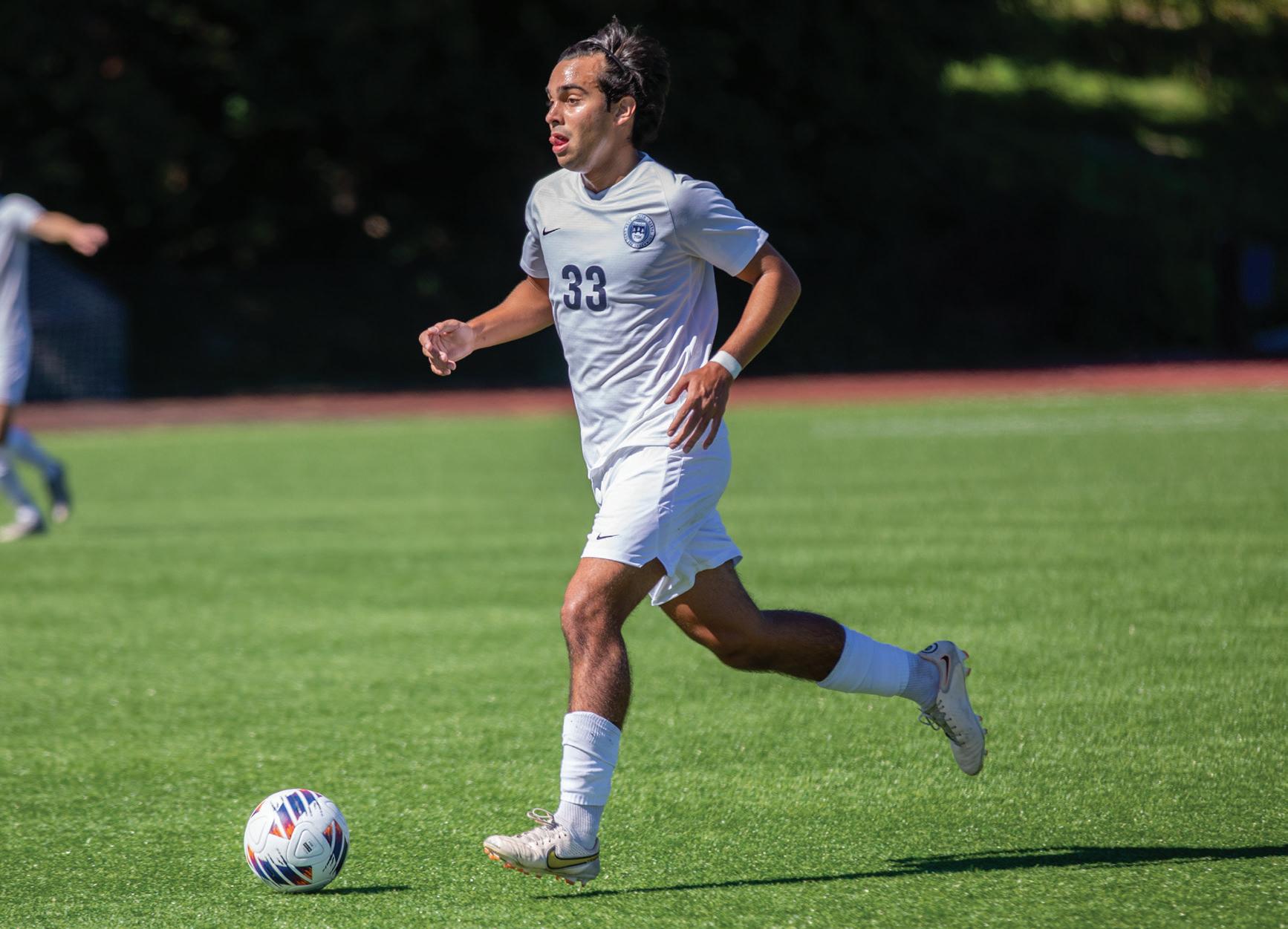 Editor’s note: Editorial Assistant Aiden Guthro ’23 is a captain of the Judges men’s soccer team and did not contribute to the writing or editing of this article.
SMILEY HUYNH/the Justice
MOVING FORWARD: Andres Gonzalez ’25 strides forward during a match at home on Sept. 24 against Eastern Nazarene.
Editor’s note: Editorial Assistant Aiden Guthro ’23 is a captain of the Judges men’s soccer team and did not contribute to the writing or editing of this article.
SMILEY HUYNH/the Justice
MOVING FORWARD: Andres Gonzalez ’25 strides forward during a match at home on Sept. 24 against Eastern Nazarene.
JUDGES BY THE NUMBERS SOCCER
THE JUSTICE ● SPORTS ● TUESDAY, OCTOBER 4, 2022 11 MEN’S SOCCER TEAM STATS UPCOMING GAMES: Assists TEAM STATS Makenna Hunt MA ’23 leads the team with 3 assists. Player Assists Makenna Hunt 3 Juliette Carreiro 2 Rachel Watler 2 Caroline Swan 2 UPCOMING GAMES: Tuesday at Bridgewater State Thursday vs. Roger Williams Goals Assists WOMEN’S SOCCER VOLLEYBALL CROSS COUNTRY Player Goals Juliette Carreiro 4 Sydney Lenhart 3 Makenna Hunt 2 Bailey Cullen 2 UAA STANDINGS Juliette Carreiro ’23 leads the team with 4 goals.W L D W L D Pct. Case 0 0 0 5 0 0 1.000 WashU 0 0 0 3 1 3 .643 Chicago 0 0 0 5 2 0 .714 Rochester 0 0 0 3 0 3 .750 Emory 0 0 0 4 2 0 .667 JUDGES 0 0 0 3 2 1 .583 NYU 0 0 0 2 0 3 .700 Carnegie 0 0 0 4 1 1 .750 UAA Conf. Overall Santo Moroto Tobias ’23 leads the team with two goals. Player Goals Santo Moroto Tobias 2 Elan Romo 1 Max Horowitz 1 Isaac Mukala 1 UAA STANDINGS Rainer Osselmann-Chai ’26 leads the team with 3 assists. Player Assists Rainer Osselmann-Chai 3 Santo Moroto Tobias 1 Elan Romo 1 Max Horowitz 1 Wednesday at Wheaton College Saturday vs. Eastern Nazarene Goals W L W L Pct. Chicago 3 0 8 5 .615 Emory 2 1 7 3 .700 Carnegie 2 1 7 3 .700 WashU 3 0 12 0 1.00 NYU 2 1 8 2 .800 JUDGES 0 3 5 4 .556 Rochester 0 3 6 5 .545 Case 1 2 9 3 .750 UAA Conf. Overall Sydney Bent MA ’23 leads the team with 85 kills. Player Kills Sydney Bent 85 Anna Ertischek 69 Lara Verstovsek 58 Arianna Jackson 37 UAA STANDINGS TEAM STATS Ella Pereira ’24 leads the team with 119 digs. Player Digs Ella Pereira 119 Sydney Bent 91 Ines Grom-Mansenecal 89 UPCOMING GAMES: Friday vs. Colby at Bates College Saturday at Bowdoin College Kills Digs W L D W L D Pct. Chicago 0 0 0 7 0 0 1.00 Rochester 0 0 0 3 1 1 .700 Case 0 0 0 3 1 2 .667 WashU 0 0 0 1 2 0 .333 JUDGES 0 0 0 2 2 1 .500 Carnegie 0 0 0 6 0 0 1.00 Emory 0 0 0 1 3 4 .375 NYU 0 0 0 3 2 1 .583 UAA Conf. Overall UPCOMING MEETS: Sat., Oct. 1 at Keene State Invitational TOP FINISHERS (Men’s) RUNNER TIME Mathew Dribben 25:48.50 Willem Goff 26:19.27 TJ Carleo 27:02.34 RUNNER TIME Bridget Pickard 18:38.71 Katriona Briggs 18:39 Juliette Intrieri 18:39.20 TOP FINISHERS (Women’s) Results from the UMass Dartmouth lnvitational on Sept. 17. 5-Mile Run 5-Kilometer Run @theJustice Follow theJustice! Image courtesy of CREATIVE COMMONS —Stats current as of Sept. 20.
Sportsjust
JUDGES MEN'S AND WOMEN'S SOCCER
Las Vegas Aces claim 2022 WNBA title
■ The Las Vegas Aces won the first professional championship for Las Vegas, wrapping up a remarkable season.
By JACKSON WU JUSTICE STAFF WRITER
As forward A’ja Wilson secured the final rebound and the clock ran out in the Mohegan Sun Arena, in Connecticut, the Las Vegas Aces captured their first franchise title in the Women’s National Basketball Association after falling short in previous seasons. This is also the first professional championship for Las Vegas, a city known for its prominent gambling industry. Aces guard Chelsea Gray won the Finals Most Valuable Player with an average of 18.3 points, six assists, a stellar 58.5 fieldgoal percentage, and a 45 percent three-point shooting percentage. Gray contributed twenty points in the championship-clinching game and has been the go-to option for the Aces during clutch times throughout the postseason.

The Aces’ 2022 season was beyond successful. Four of their players, A’ja Wilson, Dearica Hamby, Jackie Young, and Kelsey Plum, were selected as All-Stars, with Plum named as the All-Star MVP as she contributed 30 points in the game. Both Wilson and Plum were also honored in the
2022 All-WNBA team. In addition, Wilson claimed the regular season MVP and Defensive Player of the Year. Head coach Becky Hammon, who was a legendary WNBA player in her own right, was recognized as Coach of the Year, becoming the first rookiecoach to top the category. The Aces franchise finally put all their pieces together and won it all, bringing the city of Las Vegas its first professional championship.
However, the title could bear even more significance. As Nancy Lough, an education professor of University of Nevada, Las Vegas studying gender equity and diversity in sport, pointed out in an interview, children of all genders in Las Vegas can look up to these WNBA stars as they develop their game, and those who are learning about leadership can study the examples of coach Hammon and Aces’ President Nikki Fargas. The Aces’ success has already inspired the Lady Coyotes basketball team of the College of Southern Nevada, who watch and model their game after the championship victors. Since it is now the Aces who brought home the first professional title for Las Vegas, Lough states in another interview with FOX5, “the [Golden] Knights and Raiders and every other team are kind of on alert like, ‘hey, they
Celtics face setbacks as new season looms
■ The Boston Celtics will be without key pieces as the regular season starts on Oct 18.
By ZACH GOLDSTEIN JUSTICE EDITORIAL ASSISTANT
After a promising start to the offseason, the optimistic outlook for the Boston Celtics has taken a turn for the worse. In the span of two months, the championship runnerups have become the embodiment of the saying, “what can go wrong, will go wrong.”
The team internally suspended Head Coach Ime Udoka for a full season due to misconduct in the workplace. After a cryptic late-night “Woj-bomb” tweet by ESPN insider Adrian Wojnarowski referring to an “unspecified violation of organizational guidelines.” The story quickly unraveled, revealing that Udoka had an “intimate
relationship with a female member of the franchise’s staff.” As a result, on Sept. 23, the Celtics announced that Assistant Coach Joe Mazzulla would be promoted to head coach for the upcoming season.
Center Robert Williams III opted to undergo surgery on his left knee, sidelining him from basketball related activities for eight to 12 weeks. Injuries are no stranger to Williams, as they’ve plagued him throughout his five year National Basketball Association career. This left knee also caused a setback for Williams last season, resulting in him being in and out of the lineup during the playoffs. As a pivotal piece to the Celtics' championship run a season ago, Williams' spot will be a tough void to fill.
Newly acquired forward Danillo Gallinari endured a torn ACL while representing his home country of Italy during a FIBA Basketball World Cup qualifier game this summer against Georgia. Initially reported as a torn meniscus, Gallinari’s injury was elevated to a torn ACL after
NBA
LeBron James chases monumental NBA records
■ In his 19th season in the NBA, LeBron James is closing in on the NBA all-time scoring record.
By PRATEEK KANMADIKAR JUSTICE STAFF WRITER
The 77th season of the National Basketball Association will begin on Oct. 18, 2022. This season is particularly special for LeBron James, one of the greatest players of all time. James is on pace to break the NBA All-Time Career Scoring record. He is trailing Kareem Abdul-Jabbar by 1326 points. In addition, James is also on pace to pass Magic Johnson on the NBA AllTime Career Assist List; he needs only 97 more assists to pass the Los Angeles Laker legend, per an ESPN article. James is on pace to break both this year. Prominent players and sports analysts say that if James can accomplish these two feats in the same season, then he will be considered by many to be the best basketball player of all time.
LeBron James has been playing professional basketball for 19 years
and has accomplished quite a bit in that time. James is a four-time NBA Champion, four-time NBA MVP, and a four-time NBA Finals MVP. He was born and raised in Akron, Ohio, and was one of the most well known basketball players in the country when he was in high school. Considered one of the League’s most well-known “prep-to-pro” players, James went on to be the No. 1 pick in the 2003 NBA Draft.
There has been a longstanding debate on whether or not LeBron James is a better basketball player than Michael Jordan. Shaquille O’Neal, another well-known basketball player, went on record saying that “if LeBron were to pass Kareem for career scoring, then he is probably better than Jordan.” The essence of James’ legacy has been a long-standing debate for years, and it will most likely be argued for years to come. James commented on the possibility of breaking the abovementioned records, saying, “I’m in awe of the possibility of [becoming] the league's all-time leading scorer.”
He added, “Being on the verge of breaking the most sought after record in the NBA is humbling.”
The aforementioned record, the All-Time Career Scoring Leader in
the NBA, was set by Kareem AbdulJabbar on April 5, 1984. Abdul-Jabbar retired with a total of 38,327 points. This record has not been broken for over 38 years, and until recent years, nobody thought it would. Often regarded as the most coveted and well-known record in all of the NBA, there have only been a few players that came close to breaking it — including Karl Malone, the late Kobe Bryant, Michael Jordan, and Dirk Nowitzki — but they ultimately fell short.
But when will James officially break it? Well, let’s see … James is trailing Abdul-Jabbar by 1326 points. At the minimum, it could take James 49 games. The earliest possible game that the record could be broken is taking place Jan. 28 against the Boston Celtics, assuming that he maintains his career-scoring average of 27.1 points per game. Also, it would be ironic if James breaks the record against the Celtics, given that the relationship between the two is rather shaky. The majority of Celtics’ fans strongly dislike James, and vice versa. James stated in an interview, “Celtics’ fans are racist as f—.” The rivalry between the Lakers and Celtics is also extremely well-
The men’s and women’s soccer teams fell short in the UAA Weekend Opener.
Photo courtesy of CREATIVE COMMONS
CITY OF CHAMPIONS: The Vegas Aces claimed the 2022 WNBA title, marking the first major league championship for the city.
‘SIN CITY’ WELCOMES WINNERSWNBA
See NBA, 13 ☛
CELTICS
See WNBA, 13 ☛ See CELTICS, 13 ☛
Tuesday, October 4, 2022Page 12 Waltham, Mass.
 Photos: Jack Yuanwei Cheng/the Justice. Design: Owen Chan, Jack Yuanwei Cheng/the Justice.
Waltham, Mass.
Photos: Jack Yuanwei Cheng/the Justice. Design: Owen Chan, Jack Yuanwei Cheng/the Justice.
Waltham, Mass.
October 4, 2022Vol. LXXV #4
By MEGAN LIAO JUSTICE EDITOR
On Sept. 14, the producers of Hulu hit series “Ramy” an nounced the return of a third sea son, which will hit the streaming service on Sept. 30. The debut of the show dates back to spring of 2019, and the show was later re newed for season two in May of the next year. The filming pro cess of the second season was interrupted by the COVID-19 outbreak, and, cleverly, the pro ducers of “Ramy” incorporated scenes of video call shots to tie the real-life crisis into the story line.
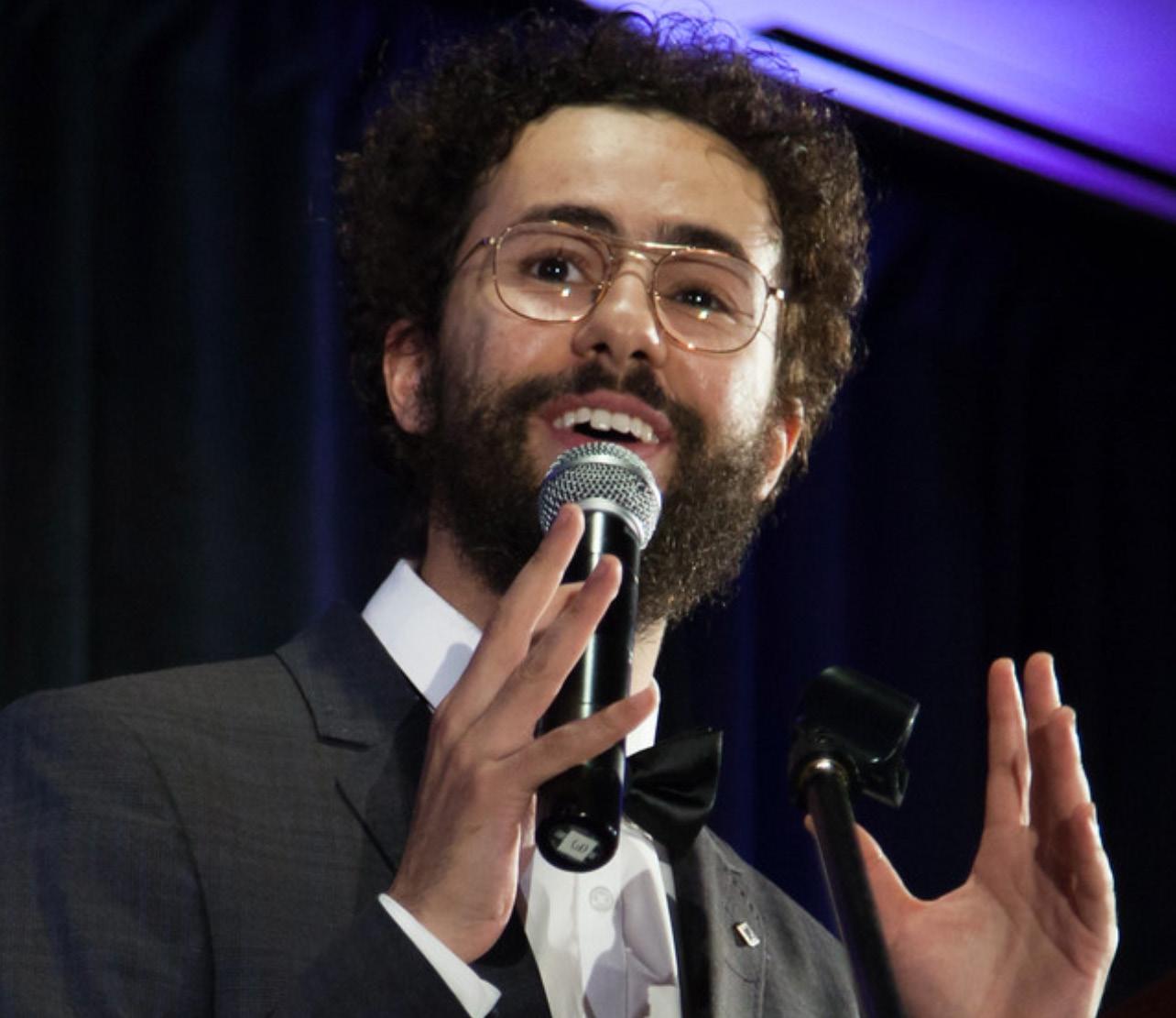
The show follows an Egyptian American, Ramy Hassan, on his quest to find religious truth in his life. Growing up with two different cultures, Ramy struggles with the contrasting sets of cultural values, in addition to his sense of identity as an American Muslim. Season one of “Ramy” surrounds the protagonist’s religious journey as well as the individual difficulties faced by his family members attempting to fit into American society as Muslims. In particular, Dena, Ramy’s sister, faces the dilemma of being a Muslim woman while pursuing her master’s degree. In the house, her uncle judges her for wearing revealing clothes, and her parents show a strong preference for her brother over her. Living under the strict household regulations, Dena is unable to experience freedom of mobility like her American counterparts.
In the discussion of modernday feminism, the immobility or lack of freedom of Muslim women seems to be a frequent topic of debate. In Western eyes,
‘Ramy’
Muslim women are a population to be pitied, for they perceive them to be restricted to a passive, domestic life and subject to male dominance. Prof. Emilie Diouf (ENG) has accredited “the construction of this particular image of a Muslim woman to the orientalist discourse.” Under the context of colonialism, the colonizers fabricated a demoralizing distinction between themselves and their “subjects.”
The legacy of colonialism fueled a twisted interpretation of the way to protect women in Islamic religion — where their religious views on domestication were interpreted to the extreme as abuse and violence. This influenced not only Europeans, but also Muslims themselves, and this image is decontextualized in contemporary Muslim society.
The immobility of Muslim women, therefore, stems from Western colonialism.
In season two, Mahershala Ali joins the cast as the wise Sheikh Ali Malik. Ramy’s immaturity grows increasingly prominent — and increasingly grotesque — which juxtaposes with Sheik Malik’s calm rationality from a rich life experience. At first glance, Ramy seems to be benefit ing from the guidance of a new spiritual mentor; but as season two unfolds, he makes decisions that are only increasingly close to the margins of morality. The end of season one leaves the au dience bewildered by Ramy’s choice to sleep with his cousin on his visit to Egypt. He appears to be in pain and regretting the affair at the beginning of season two, but at the end, the audience experiences another shock when Ramy attempts to convince his new wife to accept the fact that he has slept with his cousin and
that he wishes to make their mar riage polygamous. He argues that the Muslim religion allows for a husband to have a maximum of four wives. From struggling to live up to the standards of both cultures in the previous season, the millennial takes advantage of the two cultures in the next.
“Ramy,” in a narrower scope, illustrates a series of difficulties faced by Muslim millenials grow ing up in the United States; in a wider scope, the series shows a variety of possible choices one makes when their religion or cul ture clashes with modernity. One may argue that doctrines may not be partially chosen or rejected by individuals; when believers choose the religion, they must accept everything it suggests, whether it be polygamy or female genital mutilation. Others may frown at such statements, declar ing that one’s choices must abide by their own conscience, firmly rejecting aspects of the religion when it violates basic human rights. When religion, modern ethics, and values clash, there is not always a perfect solution, and for some people, this is a harsh reality to accept.

In Ramy’s moment of religious confusion, Sheikh Malik glances at him with a meaningful look and pronounces in his deep, throaty voice, “Islam is like an orange. There’s an outer part and an inner part. If someone only got the rules and rituals, they might think Islam is tough and bitter like the outside of an orange. But there’s an inside, a juicy flesh, the divine intimacy, the spiritual experience. The rind without the flesh is bitter and useless, the flesh without the rind would quickly rot. The outer sharia protects the inner spirituality.
And the inner spirituality gives
the outer sharia its purpose and meaning.” The vivid imagery em ployed in his discourse provides a visual analogy of the meta physical existence of religion.
Because “faith” is impossible to see with physical eyes, one can only perceive others’ religions through rites and rituals; never theless, these observations do not necessarily measure the strength of someone else’s faith. Likewise, practicing religion through per forming rites and following doc trines can channel inner faith, but it does not always transfer into a strong inner faith. In search of an answer to the question “how should we live,” Ramy faces choices one after an other, yet he seldom makes the
best choice, accidentally or de liberately. In the third season, he might be compelled to look at the consequences of his errone ous decisions rather than car rying on with only guilt in his heart. The season three trailer opens with Ramy’s confrontation with the two representative of his wife Zainab, who is cheated on by him with his cousin. “You owe us 100,000 dollars,” says the female representative coldly. The male representative adds, “It’s not just about the money. You’re in spiritual debt.” In this new season, Ramy is trapped by the consequences of his actions, and viewers can look forward to watching how he will pay off his spiritual debt.
Double dose of dopeness
By MINA ROWLAND JUSTICE EDITORIAL ASSITANT
For students like me, Black and Brown, we grew up embracing Black music whether that meant Gospel, hip-hop, rap, or R&B. Personally, my twin and I enjoyed hip-hop from the 90s, listening to artists like Lauryn Hill, Sista Souljah, and Arrested Development. Unfortunate ly, most rap and hip-hop artists engage in exploitation and dehumanization, particularly of Black and Brown women. Generally, finding uplifting, positive, and powerful music has been quite a journey for us. Luckily, early last spring semester, my twin and I discovered this group who happened to be Black twin artists. Aint Afraid is a rising musical duo perform ing hip-hop, spoken word, and R&B. The 22-year old Mulsim twin sisters, Sakinah and Zakiyyah — who are often referred to as Straingth and WiZdumb — were born in Baltimore, though they have spent most of their lives in Detroit.
They have always been involved in the music world, as their mom was an artist herself. They have been performing in their hometown since they were young, but it was not until around June of 2020 when they made their debut and started to go viral on TikTok.
I remember first listening to Rover and Benz and sharing this song with my sister. I began to watch and follow them on Spotify and Youtube. I was in awe at all of the similarities that my sister and I seemingly had with this amazing duo. They are so humble and authentic in telling their story through their music. I loved the important topics they chose to
write and sing about. They explained in a podcast interview with TMZ Verified that they have so many lived experiences within being Black, Muslim, and women, which is the epitome of intersectionality. Having a single mother raise them and their siblings, as well as living in poverty, informed their intentionality in making music that not only relates to multiple audiences but also uplifts them.
Aint Afraid stays true to their faith and to the main focus of hip-hop, which is creating socially conscious music, they explained in an interview with GQ. “Hiphop, in its essence, has a strong message of uplifting the people and keeping the history of time.”
Of course, with their success, there was a wave of praise, but also hate, which the twins navigate by being empowered rather than following the pressure of others. When asked about overcoming the challenges of the music industry and not being accepted into certain communities, they responded, “Being Black Muslim women navigating this industry, we feel like first and foremost we are authentically ourselves.” They stand tall and are constantly proud of who they are. “We dress the way we want. If you want to deal with it, deal with it. If you don’t want to deal with it, don’t deal with it.” The twins have released two albums, their most recent collection titled “Heavy Guarded Heart,” but their work goes beyond their art. They collaborated with the SPOT project in an effort to build schools in Gambia; they raised funds particularly for girls between the ages of six and fifteen. The sisters are multi-talented and extremely humble. We, especially the young Black sistas, can’t wait to see what their future holds.
MUSIC REVIEW
MINA ROWLAND/the Justice TWINS: Aint Afraid is a musical duo of twin Muslim artists.
Photo courtesy of CREATIVE COMMONS RAMY: The show Ramy is loosely based the producer’s life.
THE JUSTICE | ARTS | TUESDAY, JANUARY 31, 201714 Design: Mina Rowland and Megan Liao/the Justice
TV REVIEW
TUESDAY, OCTOBER 4, 2022 I ARTS & CULTURE I THE JUSTICE
Travel through Street
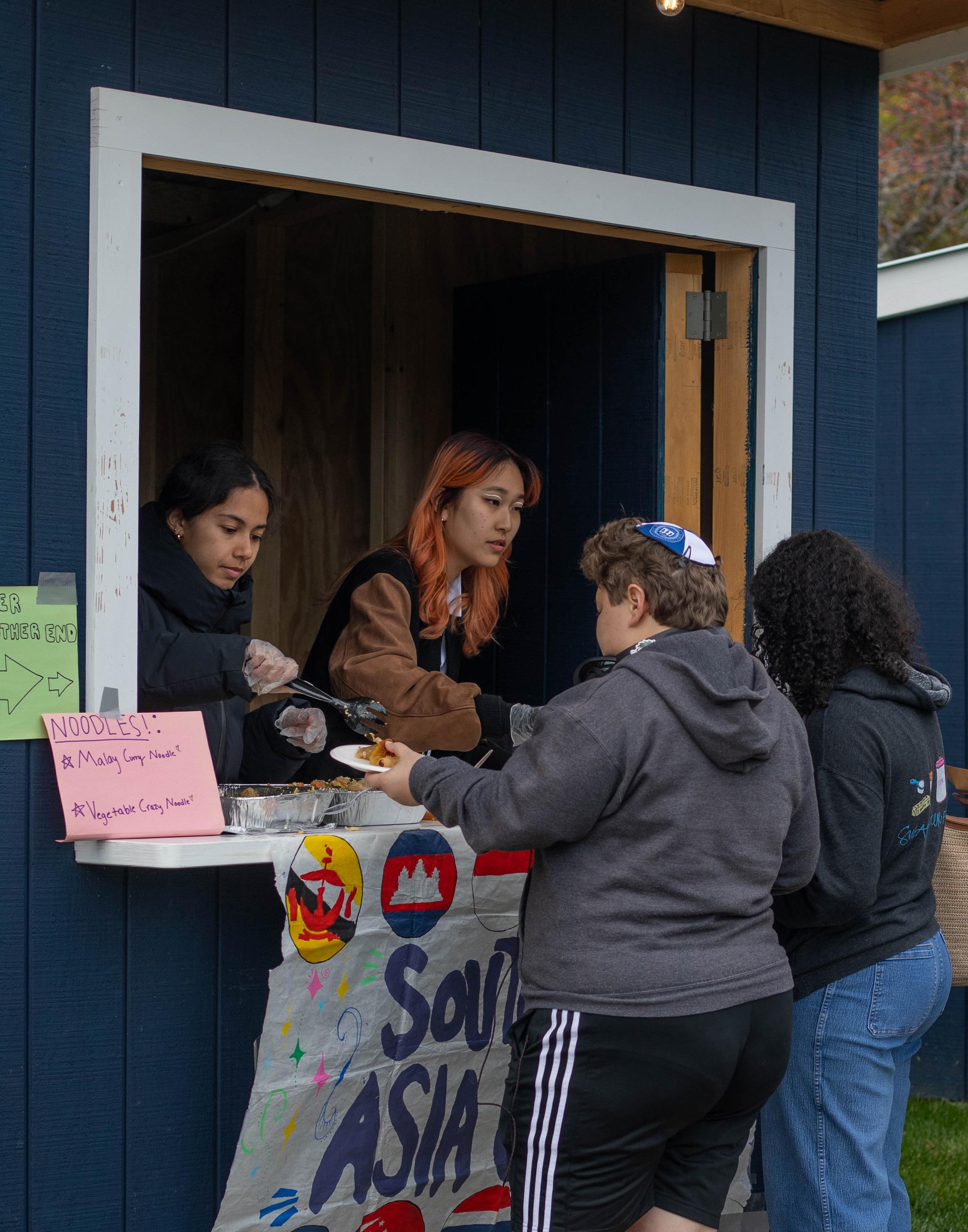
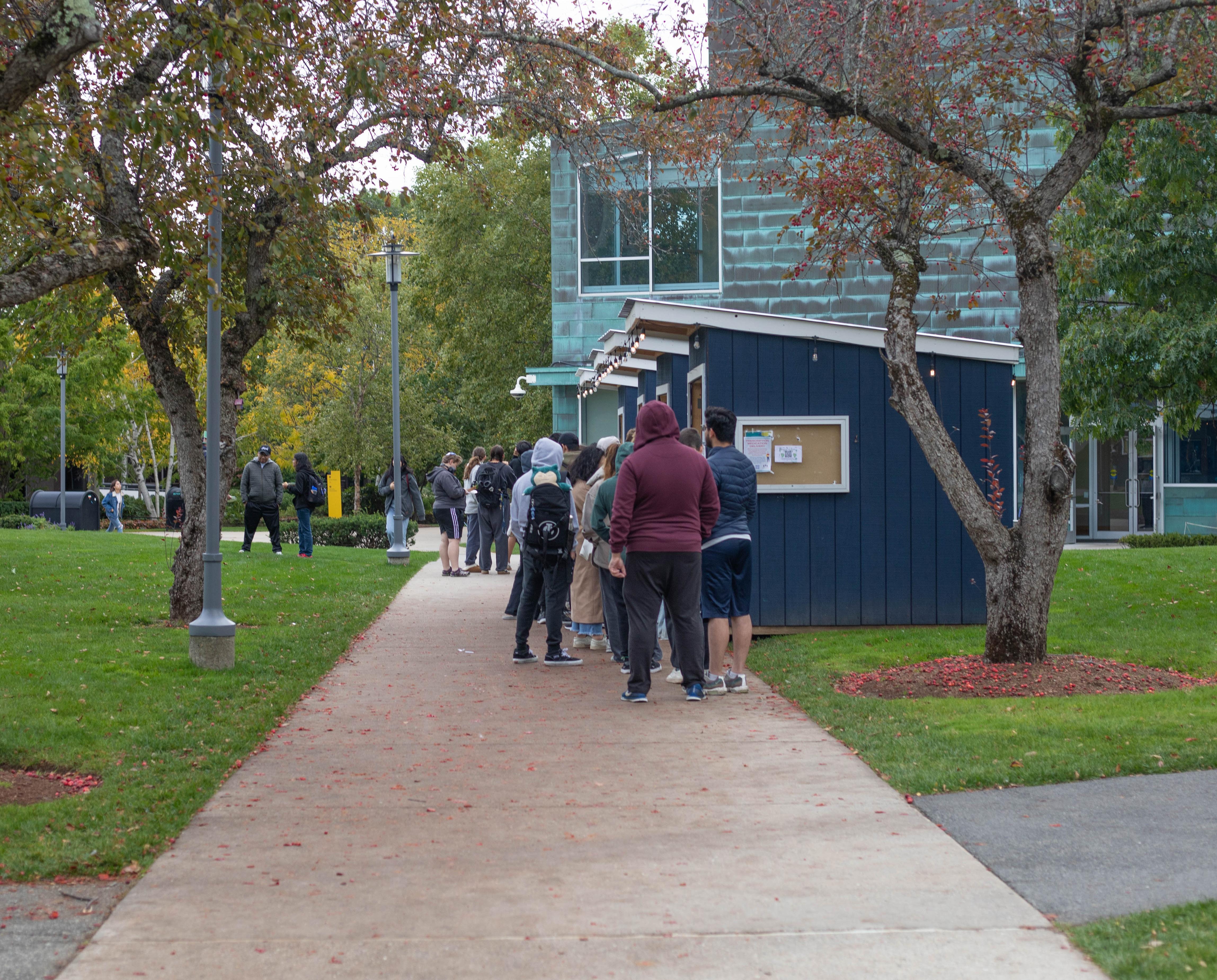
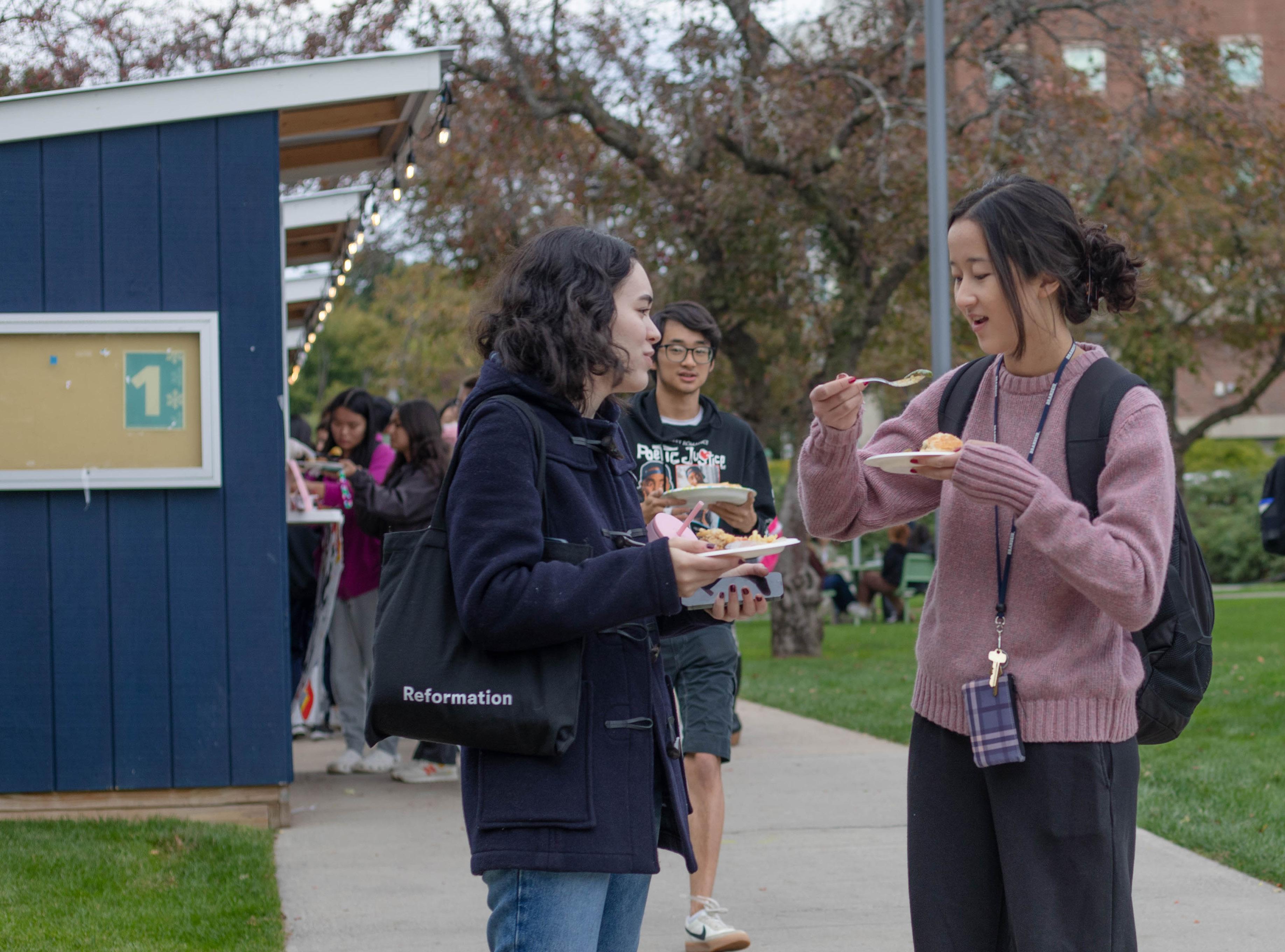

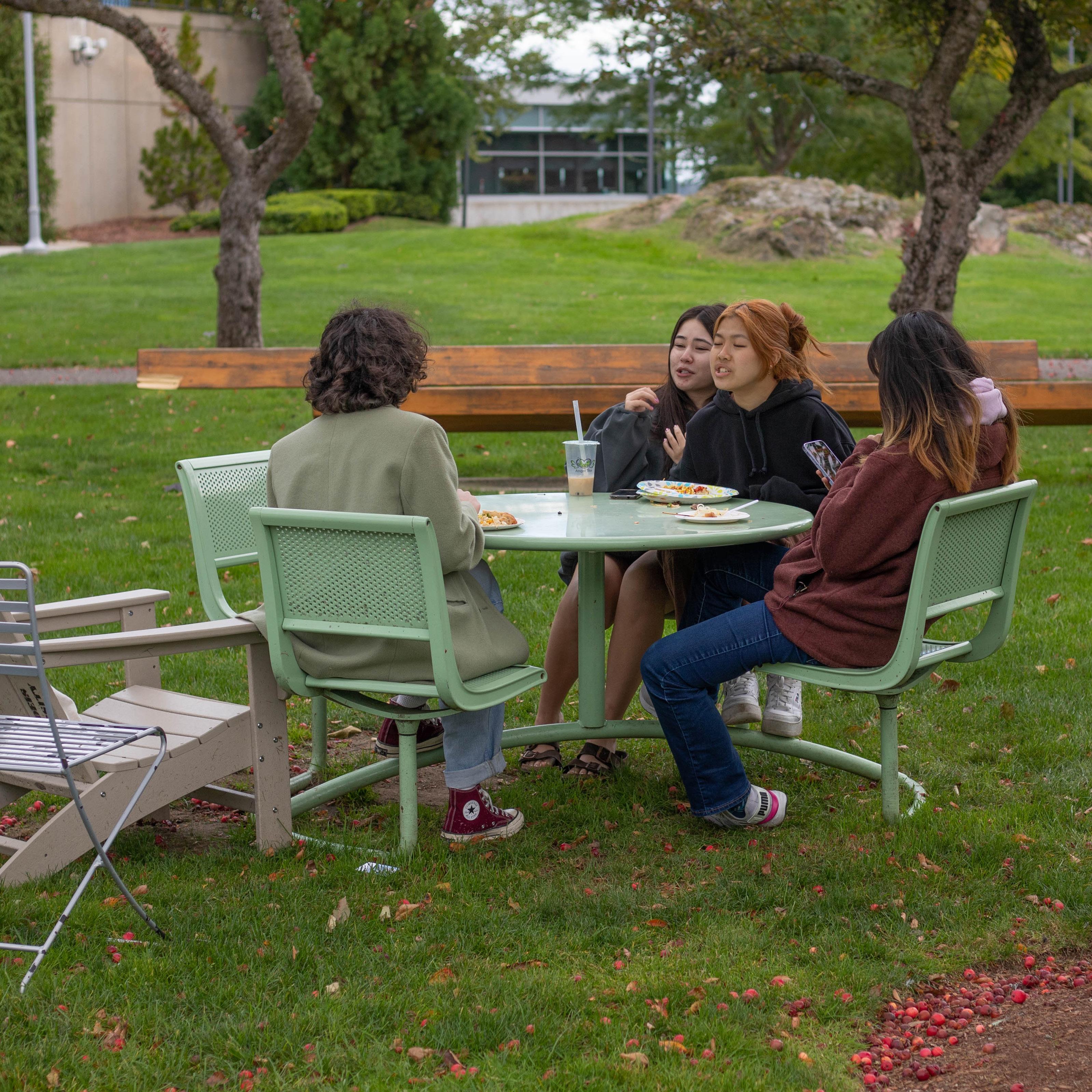 lounge. The event was full of casino games, Canton ese music, and popular Asian food like taro baos, egg tarts, and bubble tea.
PHOTO STORY
Brandeis’s South East Asian Club coordinated the event “Travel through Street Food,” hosting other cul tural clubs such as the Vietnamese Student Associa tion and South Asian Student Association. Each club served cuisines particular to their cul tures. They drew inspiration from the annual Taiwan ese Student Association event “Night Market,” which will be happening soon on Oct. 22.
By MEGAN LIAO JUSTICE EDITOR
SMILEY HUYNH/the Justice
event
Great Lawn.
SMILEY HUYNH/the Justice
NORA HERNDON-LAZARETH/the Justice
Student Association served Banhmi, a
NORA HERNDON-LAZARETH/the Justice
lounge. The event was full of casino games, Canton ese music, and popular Asian food like taro baos, egg tarts, and bubble tea.
PHOTO STORY
Brandeis’s South East Asian Club coordinated the event “Travel through Street Food,” hosting other cul tural clubs such as the Vietnamese Student Associa tion and South Asian Student Association. Each club served cuisines particular to their cul tures. They drew inspiration from the annual Taiwan ese Student Association event “Night Market,” which will be happening soon on Oct. 22.
By MEGAN LIAO JUSTICE EDITOR
SMILEY HUYNH/the Justice
event
Great Lawn.
SMILEY HUYNH/the Justice
NORA HERNDON-LAZARETH/the Justice
Student Association served Banhmi, a
NORA HERNDON-LAZARETH/the Justice
THE JUSTICE | ARTS | TUESDAY, JANUARY 31, 2017 15TUESDAY, OCTOBER 4, 2022 I ARTS & CULTURE I THE JUSTICE
Food
SEAC: SEAC hosted the
on the
VSA: Vietnamese
traditional sandwich. NORA HERNDON-LAZARETH/the Justice
By EDEN OSIASON JUSTICE EDITORIAL ASSISTANT
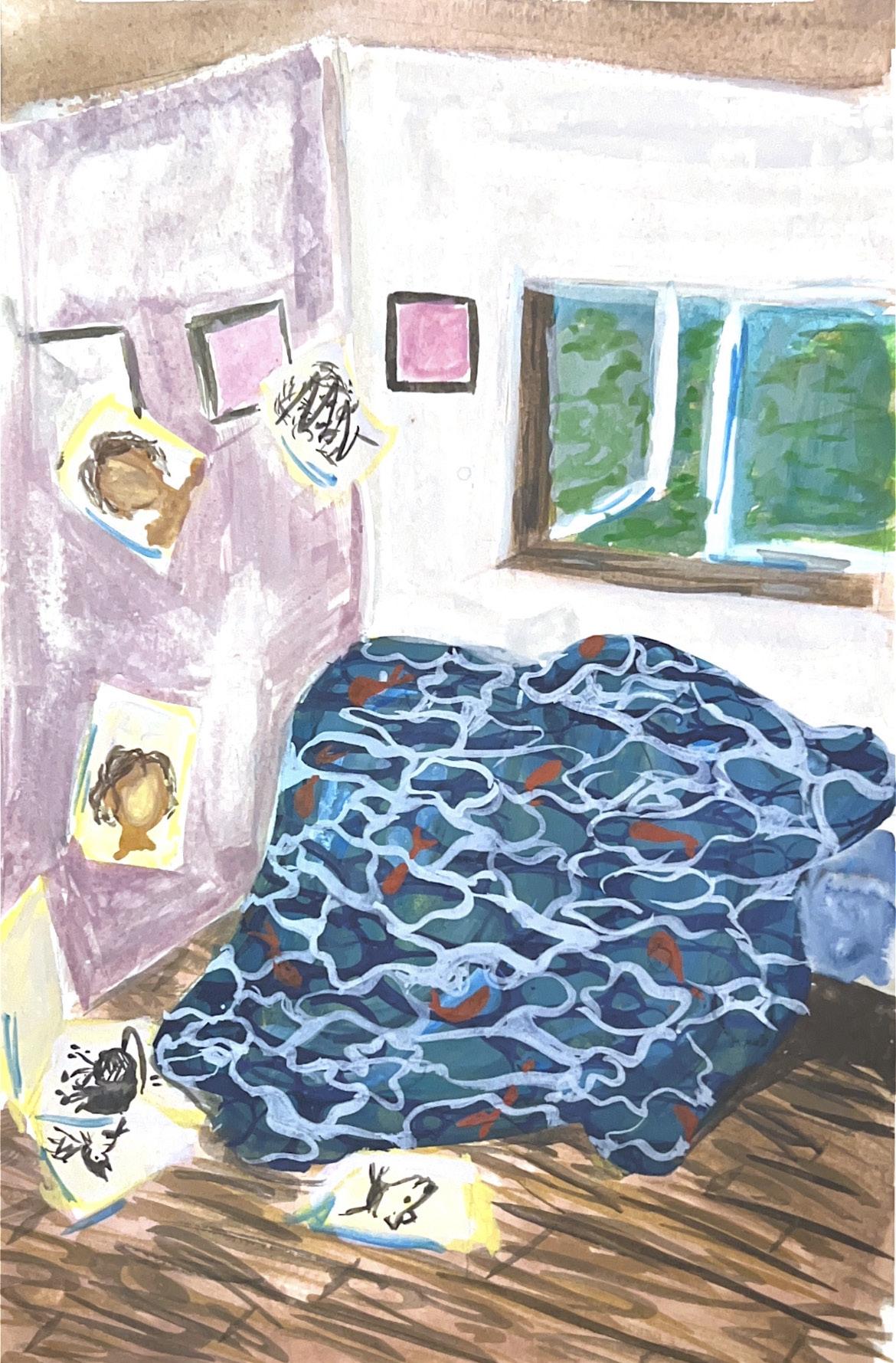
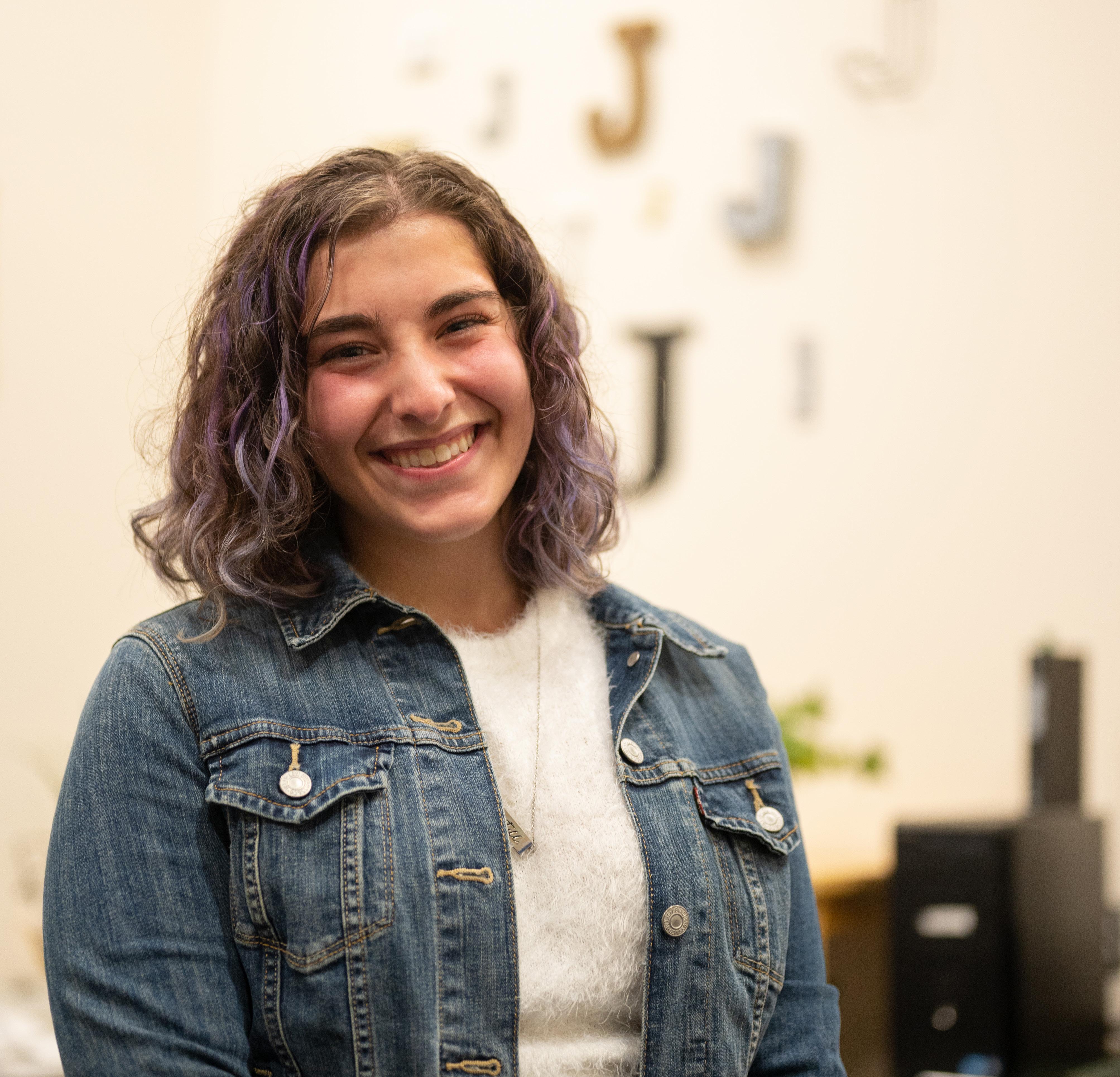
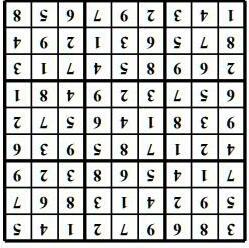
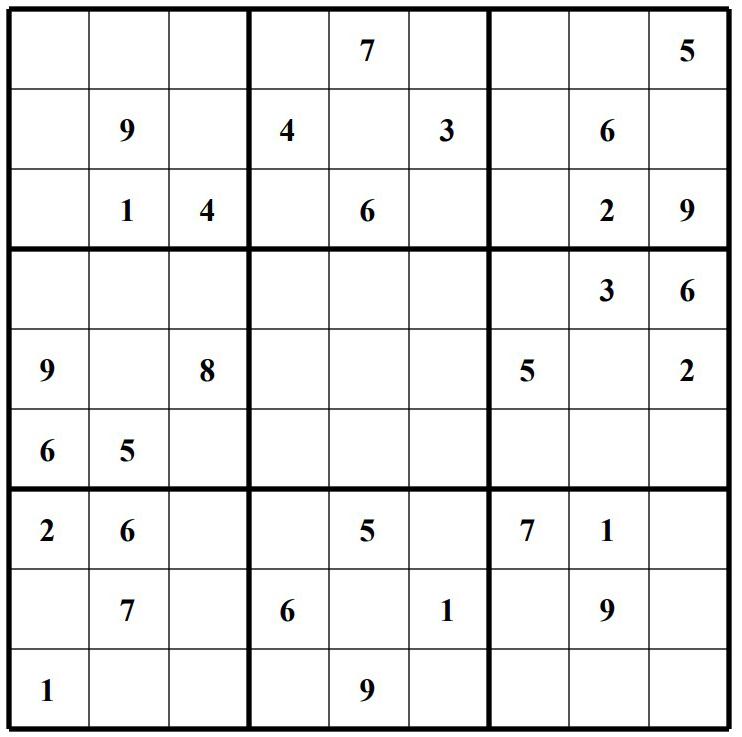
Top 10 Halloween Movies
Illustration courtesy of EMILY MCKERROW
JACK YUANWEI CHENG/the
16 It’s officially spooky season! Here is a mix of 10 movies ranging from animated classics to horror for watching in the lead up to Halloween. These movies are guaranteed to put you in the spooky spirit! 1. “Edward Scissorhands” (1990) 2. “It’s the Great Pumpkin, Charlie Brown” (1966) 3. “The Fear Street trilogy” (2021) 4. “Halloweentown” (1998) & “Halloweentown II” (2001) 5. “Jennifer’s Body” (2009) 6. “Hotel Transylvania” (2012) 7. “Hocus Pocus” (1993) 8. “The Craft” (1996) 9. “Coraline” (2009) 10. “Ghostbusters” (1984)
TUESDAY, OCTOBER 4, 2022 I ARTS & CULTURE I THE JUSTICE
Justice SUDOKU Puzzle Courtesy of OPENSKY SUDOKU STAFF’S Top Ten

 By NATALIE KAHN
By NATALIE KAHN


 By ARIELLA WEISS, ELLIOT BACHRACH, AND NATALIE SALTZMAN JUSTICE EDITOR AND CONTRIBUTING WRITERS
By ARIELLA WEISS, ELLIOT BACHRACH, AND NATALIE SALTZMAN JUSTICE EDITOR AND CONTRIBUTING WRITERS

 Max Feigelson
Max Feigelson













 're: collections, Six Decades at the Rose Art Museum' is a new exhibit organized in celebration of the museum's 60th anniversary, with art focused on the past and the future.
're: collections, Six Decades at the Rose Art Museum' is a new exhibit organized in celebration of the museum's 60th anniversary, with art focused on the past and the future.





















 By SKYE LIU JUSTICE CONTRIBUTING WRITER
By SKYE LIU JUSTICE CONTRIBUTING WRITER








 Editor’s note: Editorial Assistant Aiden Guthro ’23 is a captain of the Judges men’s soccer team and did not contribute to the writing or editing of this article.
SMILEY HUYNH/the Justice
MOVING FORWARD: Andres Gonzalez ’25 strides forward during a match at home on Sept. 24 against Eastern Nazarene.
Editor’s note: Editorial Assistant Aiden Guthro ’23 is a captain of the Judges men’s soccer team and did not contribute to the writing or editing of this article.
SMILEY HUYNH/the Justice
MOVING FORWARD: Andres Gonzalez ’25 strides forward during a match at home on Sept. 24 against Eastern Nazarene.

 Photos: Jack Yuanwei Cheng/the Justice. Design: Owen Chan, Jack Yuanwei Cheng/the Justice.
Waltham, Mass.
Photos: Jack Yuanwei Cheng/the Justice. Design: Owen Chan, Jack Yuanwei Cheng/the Justice.
Waltham, Mass.






 lounge. The event was full of casino games, Canton ese music, and popular Asian food like taro baos, egg tarts, and bubble tea.
PHOTO STORY
Brandeis’s South East Asian Club coordinated the event “Travel through Street Food,” hosting other cul tural clubs such as the Vietnamese Student Associa tion and South Asian Student Association. Each club served cuisines particular to their cul tures. They drew inspiration from the annual Taiwan ese Student Association event “Night Market,” which will be happening soon on Oct. 22.
By MEGAN LIAO JUSTICE EDITOR
SMILEY HUYNH/the Justice
event
Great Lawn.
SMILEY HUYNH/the Justice
NORA HERNDON-LAZARETH/the Justice
Student Association served Banhmi, a
NORA HERNDON-LAZARETH/the Justice
lounge. The event was full of casino games, Canton ese music, and popular Asian food like taro baos, egg tarts, and bubble tea.
PHOTO STORY
Brandeis’s South East Asian Club coordinated the event “Travel through Street Food,” hosting other cul tural clubs such as the Vietnamese Student Associa tion and South Asian Student Association. Each club served cuisines particular to their cul tures. They drew inspiration from the annual Taiwan ese Student Association event “Night Market,” which will be happening soon on Oct. 22.
By MEGAN LIAO JUSTICE EDITOR
SMILEY HUYNH/the Justice
event
Great Lawn.
SMILEY HUYNH/the Justice
NORA HERNDON-LAZARETH/the Justice
Student Association served Banhmi, a
NORA HERNDON-LAZARETH/the Justice



